

SECTION |
PAGE |
85 |
|
335 |
|
453 |
|
501 |
|
551 |
|
587 |
|
629 |
|
657 |
|
691 |
On the following pages I focus on fresh, whole, natural, nutrient-rich foods with many health-promoting benefits. Emphasis is on the value of minimally processed, non-genetically altered, and additive-free foods, which are organically grown whenever possible.

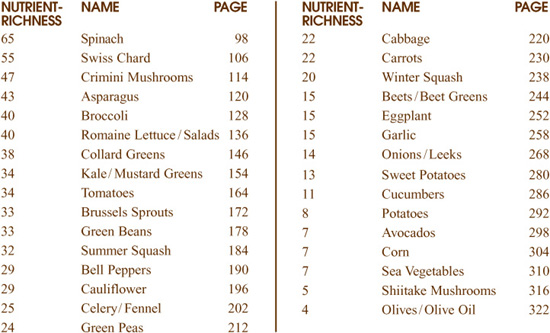
The numbers beside each food indicate their Total Nutrient-Richness. (For more details, see page 805.)

Vegetables
Vegetables are now taking center stage. Public health recommendations are emphasizing the importance of vegetables as the cornerstone of the “Healthiest Way of Eating.” This advice is based on the wealth of scientific studies that have shown the incredible benefits of the health-promoting nutrients that vegetables contain. Including plenty of vegetables as part of your daily menu not only promotes long-term health, but provides energy and helps you look your best.
One of the primary reasons that people avoid eating vegetables is that traditional cooking methods often result in overcooked, mushy vegetables that have little flavor. Those overcooked vegetables may also have lost as much as 80% of their nutrients!
This is why I want to share with you the al denté “Healthiest Way of Cooking,” so you will never have to eat bland-tasting, overcooked vegetables again. Al denté is a quick and easy way to prepare crisp, tasty, enjoyable vegetables in just minutes. In addition to improving taste, cooking vegetables al denté provides you with the maximum nutritional benefits.
By using the “Healthiest Way of Cooking” methods to prepare your vegetables al denté, you’ll discover how easy it is to add vegetables to your diet. You’ll experience the benefits of incorporating vegetables as a regular part of your meals, just as they have done for centuries in Asia and the Mediterranean regions of Europe where the people are renowned for their exceptional health and longevity.
All of the recipes and cooking methods for vegetables and other World’s Healthiest Foods (presented in this book) have been thoroughly tested many times in my own kitchen, which is not a commercial kitchen, but one that is probably very similar to your own.
Botanists describe vegetables as herbaceous (non-woody) plants that can be consumed as food. Vegetables come in many sizes and shapes and from different parts of the plant. Some are leaves (spinach, lettuce), some are roots (carrots, beets), some are stalks (celery, fennel), some are tubers (potatoes, sweet potatoes), some are inflorescents (flowering vegetables like broccoli and cauliflower) and others are bulbs (garlic, onions).
Some foods we think of as vegetables are technically fruits. It’s fairly easy to tell which vegetables are actually fruits by slicing them open and seeing the seeds inside. Among these are tomatoes, peppers, squash, eggplant, avocados and cucumbers. Since they are usually considered vegetables from a cooking perspective, however, I have included them in this section of the book.
We need to eat vegetables every day because they supply an incredible amount of health-promoting water-soluble vitamins. Our bodies require these nutrients to be supplied daily because, unlike fat-soluble vitamins (such as vitamin A, E and D) that our bodies can store for future use, the water-soluble vitamins (vitamin C and vitamins B1, B2, B3, B5, B6, B12 and folic acid) can only be stored in small amounts or not at all. Since vitamins cannot be produced by the body and can only be obtained from the food we eat, they are called “essential nutrients.” Vegetables’ rich concentration of water-soluble vitamins is just one reason why the U.S. government guidelines for a healthy diet recommend eating at least 2½ cups, or 5 servings, of vegetables every day.
Eating the recommended 5 servings of vegetables a day helps promote optimal health. Our bodies are very adaptive and can obviously survive on less, but not without long-term costs to our health. Negative effects may be subtle and go unnoticed for awhile as they may take a long time to fully develop. However, they can’t be avoided; without adequate servings of vegetables, we deprive our bodies of excellent sources of vitamins and minerals essential to proper physiological functioning as well as dietary fiber and literally thousands of protective phytonutrients, the importance of which is just now being revealed in the scientific research. The effects of not eating enough vegetables may range from low energy levels to reduced immune function and many types of degenerative diseases. Eating vegetables every day is the way to ensure that we feel our very best.
Vegetables are the most nutrient-rich foods. That means they are the foods that provide the most vitamins, minerals and phytonutrients (plant nutrients) for the least number of calories, so they help keep you slim and energized. The fact that vegetables are rich in nutrients and low in calories is especially significant today when obesity is the fastest growing cause of disease and death in the United States. Eating foods high in calories and low in nutrients is a leading cause of obesity and poor health. Therefore, it is especially important to include more low-calorie, nutrient-rich foods in your menu for both your long-term health and your appearance.
A recent USDA study found that people whose diets consisted of more than 55% carbohydrates from vegetables, fruits and whole grains consumed 200 to 300 fewer calories a day than those who ate the standard American diet. They also had the lowest Body Mass Index (BMI) scores. BMI is a measure of body fat based on height and weight that is used to determine whether individuals are overweight or underweight.
Eating a variety of vegetables as a regular part of your meal plan helps you to stay slim and provides the energy and vitality necessary to really enjoy daily life. All of us depend on complex carbohydrates for energy and vitality. The starchy portion of complex carbohydrates is converted into glucose, which is used to produce energy in our cells. However, the energy contained in glucose can only be released in combination with vitamins and minerals. The most important of these include all of the B vitamins, vitamin C and minerals like zinc. Vegetables are some of the best sources of these nutrients, which are essential for turning carbohydrates into energy rather than storing them as fat. So, eating plenty of vegetables rich in complex carbohydrates is a sure way to help you stay both slim and energized.
Vegetables are also one of the richest sources of calcium, a mineral that plays a host of important roles in the body, including helping to maintain bone health. (For more on Calcium, see page 738.)
Vegetables, along with fruits, are taking the forefront in helping people to stay healthy because they are the most concentrated sources of health-promoting phytonutrients.
Phytonutrients are the compounds that not only provide vegetables with their intense colors but also help protect them as they grow and mature. Some of the more familiar phytonutrient families include flavonoids, which are found in red and purple vegetables such as beets and red cabbage, and carotenoids, which are found in yellow, orange and red vegetables such as carrots, tomatoes and winter squash. Chlorophyll phytonutrients provide plants, such as kale and Swiss chard, with their bright green color.
These phytonutrients, as well as others found in vegetables, help protect your health, just as they help protect the plants themselves. The different types of phytonutrients work together to provide powerful antioxidant protection from cellular damage in the body’s cardiovascular, immune, respiratory and central nervous systems. The more vegetables you eat, the more phytonutrients you will consume, and the more you will benefit from their health-protective properties.
Lutein, betacarotene and lycopene are just a few of the phytonutrients that researchers are now discovering have numerous health benefits. They estimate that one day up to 40,000 phytonutrients will be identified and their benefits understood. Today, the cruciferous vegetables (broccoli, cauliflower, cabbage, kale, collard greens, mustard greens and Brussels sprouts) and the Allium family of vegetables (onions, garlic and leeks) are among the vegetables most studied for their phytonutrient content. All of these vegetables are known for their health-promoting sulfur compounds, which have been found to reduce the risk of heart disease and cancer. (For more on Phytonutrients, see the Q&A, “Are Vegetables and Fruits Equally Good for My Health?,” see page 160.)
New scientific studies are now revealing fascinating findings that identify the health-promoting flavonoid phytonutrients as the compounds that give vegetables their bitter flavor. (For more, see “Are Bitter Vegetables Better for You?” on page 161.)
Most animals thrive on diets consisting almost exclusively of raw, uncooked foods. However, you only have to watch how grazing animals eat to realize the amount of chewing they must do to process raw foods. Few people have the time to chew their food long enough to obtain the full nutritional benefits from raw foods.
There is some concern about the destruction of enzymes when vegetables are cooked; however, enzymes aren’t destroyed by cooking. Enzymes are proteins, and the proteins still remain in the food after it’s cooked. Cooking deactivates enzymes so that they no longer function as enzymes, but they remain proteins that can be useful to the body. The enzymes found in vegetables may also be deactivated when they are taken out of the ground, cut off from their roots or harvested in some other way. These activities may dramatically change their metabolism.
Our primary digestive enzymes include proteases and peptidases (to digest proteins), amylases and saccharidases (to digest carbohydrates) and lipases (to digest fats). Although raw foods contain some of these enzymes to help digestion, most enzymes found in raw foods are not digestive enzymes. Our digestive tracts also have their own digestive chemistry, which also denatures enzymes. For example, our stomach is extremely acidic, and its level of acidity denatures many enzymes even more quickly than cooking.
Recent scientific research also shows that you can get more nutritional benefits from eating quickly cooked vegetables than from eating them raw. Vegetables that are cooked quickly, as in the al denté method of cooking (see page 92), have been found to release more nutrients inside of the digestive tract, resulting in greater assimilation of those nutrients. Other studies have shown that the amount of chlorophyll absorbed by the body is greater when the vegetables were quickly cooked. Cooking vegetables al denté for a short period of time can actually make food easier to digest and therefore less stressful on your digestive tract.
This does not mean that I do not support enjoying raw vegetables. Raw vegetables add color, taste and texture to our diets. I have included many recipes showing how to enjoy vegetables raw. Raw vegetables are easy to pack in lunches, make wonderful salads and snacks and are a rich source of many nutrients. However, I feel that properly cooking vegetables can add even more flavor and nutrition to your meals.
Properly cooking vegetables (using short cooking times) plays a key role in how much you will benefit from the vegetables that you eat. Cooking aids in the digestion of vegetables by breaking down cell walls, a job your body would have to do if they were not cooked and you didn’t chew thoroughly. Our digestive system has lost the ability over the last thousand years to easily digest raw vegetables. I’ve seen firsthand the potential benefits that can be derived from properly cooking vegetables, and I’ve also seen the problems that can occur from improper cooking methods. That’s why I’ve focused much of my time and effort in coming up with methods of cooking that not only enhance the flavor and texture of vegetables but also promote good digestion and preserve as much of their original nutrient content as possible. I call this the “Healthiest Way of Cooking” (see page 45).
Here are some of the scientific findings that support the health benefits of eating quickly cooked foods compared to relying solely on a raw foods diet:
MORE CAROTENOIDS: Carotenoids are usually hooked together with proteins or locked into their own crystallike structure when found in their natural state. Heating helps break down these structures, freeing carotenoids for digestion and absorption into our cells. Research has measured the increased availability of carotenoids after vegetables have been cooked. For example, about 40% more betacarotene is released from carrots and made available through cooking.
FEWER ALKALOIDS: The alkaloid content of nightshades is problematic for some individuals. Cooking can lower the alkaloid content by as much as 40–50%. (For more on Nightshades, see page 723.)
FEWER GOITROGENS: Although research studies are limited in this area, cooking does seem to reduce goitrogens. These compounds can cause enlargement of the thyroid gland in people who are susceptible to goiters. (For more on Goitrogens, see page 721.)
FEWER OXALATES: Cooking can help reduce the oxalates found in vegetables by 5 to 15%. Although this reduction is small, it may still be beneficial for individuals needing to restrict their oxalate intake. Boiling is the best cooking method when there is concern about the oxalate content of vegetables because direct contact between the vegetable and the water helps to leach oxalates out of the vegetable and into the water. (For more on Oxalates, see page 725.)
LESS SALMONELLA AND E. COLI BACTERIA: These bacteria are sometimes found on raw sprouts because they are grown under warm and humid conditions. This is true whether they are grown commercially or in the home. The heat from cooking can help destroy the bacteria in sprouts as well as any other types of bacteria that can be found on some vegetables (see page 00).
There is a fine balance when it comes to cooking vegetables. While lightly cooking vegetables enhances their flavor and nutritional benefits, overcooking not only reduces flavor but also results in the loss of many of their health-promoting nutrients. Overcooking some vegetables can occur in as little as seven minutes.
The chart below illustrates how overcooking vegetables by boiling in water and subjecting them to very high temperatures for an extended period of time can result in substantial nutrient loss.
Overcooking can make healthy vegetables much less healthy by causing a loss of chlorophyll, magnesium and other water-soluble vitamins, minerals and phytonutrients. Overcooking vegetables by cooking for too long or at excessively high temperatures can also alter the structure of nutrients, including protein and fiber, and decrease their health benefits.
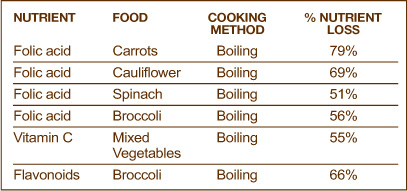
The following is a list of the standard serving sizes for vegetables:

The idea of trying to eat 5 servings of vegetables a day can seem overwhelming. Yet, if you remember that one serving is only a 1/2 cup of cooked vegetables, and therefore one cup of cooked vegetables provides 2 of the recommended 5 servings, then suddenly it does not seem so difficult.
In this book, I will share with you flavorful recipes using the al denté method of cooking that not only make vegetables easy to prepare but so tasty that you will want to eat at least 5 servings a day because they are so enjoyable! While the U.S. Dietary Guidelines recommends including at least 5 servings of vegetables a day, there are plans to soon increase this recommendation to 13. Here are a few suggestions of how to easily include more vegetables in your diet:
Start your day with a healthy vegetable frittata and get a serving of vegetables at breakfast or serve omega-3 rich eggs on top of a combination of spinach, mushrooms and tomatoes. (1 serving of vegetables)
Start lunch with a mixed salad that contains a variety of vegetables, such as lettuce, tomatoes, avocados and cucumbers, and get 4 servings of vegetables in one dish. You can also enjoy one of the book’s many salad entrées. (4 servings of vegetables)
Start dinner with a salad or vegetable crudités as appetizers. Have green vegetables like broccoli as a side dish and substitute vegetables such as carrots or squash for pasta or rice to accompany your fish or meat. (4 servings of vegetables)
This day’s menu provides 9 servings of vegetables.
Each vegetable chapter is dedicated to one of the World’s Healthiest Vegetables and contains everything you need to know to enjoy and maximize its flavor and nutritional benefits. Each chapter is organized into two parts:
1. VEGETABLE FACTS describe each vegetable and its different varieties and peak season. It also addresses the biochemical considerations of each vegetable by describing unique compounds that may be potentially problematic for individuals with specific health problems. Detailed information of the health benefits of each vegetable can be found at the end of the chapter.
2. THE 4 STEPS TO THE BEST TASTING AND MOST NUTRITIOUS VEGETABLES include information on how to best select, store, prepare and cook each one of the World’s Healthiest Vegetables. This section also features Step-by-Step Recipes and Flavor Tips. While specific information for individual vegetables is given in each of the specific chapters, here are the 4 Steps that can be applied to vegetables in general, including those not included in the list of the World’s Healthiest Foods.
1. the best way to select vegetables
Adding vegetables to your “Healthiest Way of Eating” begins with selecting the best quality vegetables, which means the freshest, most nutritious vegetables—those that are organically and locally grown whenever possible. I select organically grown vegetables because they are produced without the use of pesticides and are not coated with the wax commonly found on conventionally grown varieties of vegetables such as cucumbers, tomatoes, eggplant, peppers and squash. (For more on Organic Foods, see page 113.)
I like to purchase locally grown vegetables whenever possible not only because they are fresher but also because they are better for the economy and the environment since they don’t have to be transported over long distances, which saves fuel and contributes less to air pollution. I also recommend purchasing vegetables that are in season; studies have found that vegetables enjoyed in the height of their season contain the highest nutritional value. For example, researchers in Japan discovered that spinach contains three times more vitamin C during the peak of its season. Local, organically grown vegetables in season are the first choice of many of the most highly regarded restaurant chefs.
I also check for the maturity of my vegetables. Although vegetables do not ripen like fruits, they do reach maturity. Not only are they past their prime when they are tough, woody or show signs of decay but they have lost much of their nutritional value. In each of the vegetable chapters, I will share with you information about what features to look for to help you select the freshest, most flavorful and most nutrient-rich vegetables.
In the mid-1990s, the Environmental Working Group (EWG) developed their “Dirty Dozen” list of fruits and vegetables containing the highest levels of pesticide residue. Since then, other non-profit groups, such as Mothers and Others and the Consumer Union, have done similar analyses. In 2006, EWG updated their list. The following chart shows the World’s Healthiest Vegetables that are included amongst the “Dirty Dozen” when they are conventionally grown; it also shows the World’s Healthiest Vegetables that were found to have the least pesticide residues.
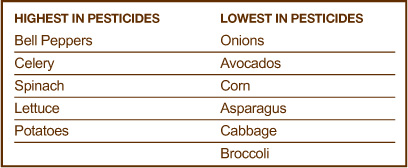
You can cut your pesticide intake substantially by avoiding the “Dirty Dozen.”
Although I am a strong proponent of selecting organically grown vegetables and fruits whenever possible, I believe it is especially important to select the organically grown varieties of the vegetables that have been found to have the highest level of pesticide residue. If you can’t find organic foods, you can cut your pesticide intake by 80% by selecting vegetables from the list of vegetables that contain the least amount of pesticides. (For more information on Organic Foods, see page 113.)
2. the best way to store vegetables
Once harvested, vegetables are much more susceptible to oxidative damage because they are no longer alive and cannot replenish their defenses. Because of this, proper storage must take the place of the ability the vegetables once had to defend themselves when they were growing. Vegetables will deteriorate much more quickly if not properly stored.
When vegetables are harvested, they have a reserve of protective nutrients. Since vegetables continue to respire after they have been picked, these nutrients are continually being used up to protect them from the oxidative effects of respiration. When these nutrients are used up, the vegetables will spoil. Thus, the key to maintaining vegetables’ freshness is to minimize their respiration rate by storing them properly. Properly storing vegetables reduces their respiration rate, which helps retain their freshness, conserves their protective phytonutrient reserves and maximizes their nutrient retention.
Different vegetables have different respiration rates. As noted above, this is important because the respiration rate is related to how quickly a particular vegetable will spoil. The faster a vegetable respires, the more easily it will spoil and the more important it is to store it correctly.
The following list provides the respiration rates of several different vegetables. It will help you to understand why some vegetables, such as potatoes, can be stored longer (up to one month) than others, such as green beans (two days if not refrigerated and properly stored). Rates are measured in terms of how much carbon dioxide is given off in mg (mg) per kilogram (kg) of vegetable every hour (hr) for vegetables kept at room temperature (68°F/20°C).
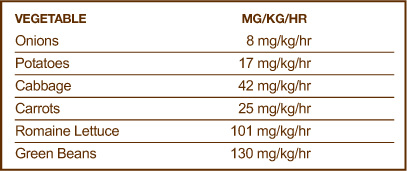
Refrigeration (36°–40°F/2°–4°C) is the best way to reduce the respiration rate of most vegetables and prolong their freshness. It is the most common method of storing vegetables and helps retain their vitality and nutritional value, especially their vitamin C. For example, at room temperature, cabbage can lose approximately 30% of its vitamin C in just two days.
How much the respiration rate will be reduced by refrigeration depends on the type of vegetable, the exact way it is stored in the refrigerator (in a plastic container, wrapped in plastic and/or in a storage bin are some of the best ways), and where in the refrigerator it is kept (different parts of the refrigerator differ in temperature with the back of the bottom shelf being the coolest). One study found that honeydew melons decreased in respiration rate by three times when refrigerated, while other studies have indicated that shelf life was doubled when vegetables were kept in the refrigerator.
Some plastic vegetable storage bags have tiny air holes, which reduce surface moisture while still decreasing air flow, so they minimize spoilage better than the bags provided at your local market. Tightly fitting glass or plastic storage containers are also good options as they can reduce exposure of your vegetables to air. You can also purchase specialty bags from the produce section that can keep your vegetables fresh for even longer periods of time; however, these bags can be quite expensive.
Some vegetables are best not refrigerated but are better stored in a cool dark environment at temperatures of about 50°–60°F (10°–16°C). These vegetables—including tomatoes, potatoes, avocados, onions, garlic, winter squash and eggplant—are adversely affected by refrigeration. For example, tomatoes lose their flavor, avocados will rot, the starches in potatoes will turn to sugar and garlic will get moldy and mushy. These vegetables should only be refrigerated if they have been cut.

Avocados can be refrigerated after they have been ripened.
Do not wash vegetables before refrigeration because exposure to water will encourage them to spoil.
Vegetables should be handled with extreme care to prevent bruising. Any kind of cell damage can degrade their vitamin content, especially vitamin C.
3. the best way to prepare vegetables
Preparation is important. Cleaning vegetables properly is the first step in healthy preparation. Here are the best methods I have found for cleaning organic and conventionally grown vegetables:
(a) Wash organic vegetables well under cold running water.
(b) Wash conventionally grown vegetables in a solution of mild dishwashing liquid then rinse with water; this can eliminate some pesticides and fungicide residues. However, washing with soap or detergent does not remove the wax that is used to retain the moisture and increase the shelf life of conventionally grown vegetables like bell peppers, cucumbers, tomatoes, squash and eggplant. Only peeling will remove this wax.
When cleaning leafy green vegetables like spinach, I do not advise soaking them for a long period of time (more than one or two minutes) because water-soluble vitamins (such as vitamins B and C) will be lost by soaking.
(c) It is best to rinse salad greens under cold running water.
(d) It is best to cut vegetables into small pieces when using the al denté method of cooking because small pieces cook more quickly and therefore retain more nutrients. (For more on Al Denté, see below.)
For more information on washing vegetables, see page 219.
4. the healthiest way of cooking vegetables
When it comes to cooking vegetables, I’d like to share with you my experiences in Italy.
When I was in Italy at the Bugialli Cooking School in Florence, I learned how to cook perfect pasta from the world’s expert, Giuliano Bugialli. The term used to describe perfectly cooked pasta is al denté, which means tender, but not mushy, firm to the bite and retaining its shape.
Like pasta, vegetables can also easily become mushy and unappetizing. Historically, boiling vegetables until they were soft was the way they were usually cooked. They were also prepared with meats, in curries or other dishes that required a long time to cook, which also resulted in overcooked and tasteless vegetables. I became most concerned with this when I found that not only did these cooking methods cause a loss of flavor but more than half of the nutrients in the vegetables were also lost.
When I started incorporating more vegetables into my meals, I became determined to find a better way to cook them because I knew that proper cooking could make them more tasty and nutritious. So, when I learned to cook pasta al denté, it inspired me to also cook vegetables al denté. I believed that cooking vegetables al denté would bring out the inherently wonderful taste of vegetables and make them really enjoyable to eat. Since then, I have spent years perfecting the ways to cook vegetables al denté to come up with vegetables that are crisp, tender and full of flavor—appetizing vegetables that you can eat with full enjoyment. Because each vegetable is unique, and there were many variables to consider, I prepared some vegetables over 100 times until I got it right.
I always believed that if I showed people how to cook vegetables al denté, they would eat more vegetables because they would be more enjoyable. I avoided overcooking all of the World’s Healthiest Vegetables by cooking them al denté. My al denté vegetables were my contributions to potlucks and parties where they were always one of the first dishes to disappear. My friends loved them because the vegetables tasted great, and they wanted me to teach them how to cook vegetables al denté. They discovered that cooking vegetables al denté was easy, fun and not complicated at all.
Now, with this book, you can discover this as well. You will see how al denté cooking brings out the best taste of vegetables yet does not require a lot of work; you just need to know your vegetables. This is the reason I have devoted a chapter to each of the World’s Healthiest Vegetables and explain in detail their individual uniqueness. Not only do al denté vegetables taste great but this method of cooking enhances flavor, brings out color and preserves nutrients.
ENHANCES FLAVOR: Vegetables cooked al denté have the best flavor. They are crisp and flavorful with no unpleasant odors. This is because they are cooked al denté, just long enough to soften the cellulose and hemicellulose to make them crisp inside and tender outside, which is when their flavor is at its peak. Letting vegetables cook for as little as two minutes longer than the time required to cook them al denté causes them to lose their flavor and texture.
Have you ever noticed that when you cook some vegetables, they emit an unpleasant odor that negatively impacts their flavor? This is because cooking for too long results in the release and concentration of compounds that can give vegetables an unpleasant odor and taste, such as the smell of rotten eggs that comes from the hydrogen sulfide gas emitted from cruciferous vegetables when they are overcooked. When you cook vegetables al denté, you won’t have to worry about this. The short cooking time does not allow the time for many of these compounds to form.
BRINGS OUT COLOR: When a green vegetable is cooked al denté, its color becomes a bright, vivid green. The vibrant color is a sign that its nutritional value, flavor and texture are at their peak. A fresh, uncooked vegetable has air between its cells, which masks its true bright color. Within the first minute of cooking, the air begins to disappear from the cell, causing the color of vegetables to brighten. For example, the color of broccoli continues to increase in intensity during the first 5 minutes of cooking, reflecting the peak of nutrient content. Yet, after 5 minutes, you can actually watch the loss of nutrients with your own eyes as the vegetable begins to lose its natural color. So, bringing out the color of vegetables is not only important aesthetically, it’s also important nutritionally.
PRESERVES NUTRIENTS: It turns out that when we preserve the color of vegetables, we are preserving more than just their aesthetic value. The rainbow of colors created by phytonutrients offers a variety of health-promoting benefits as well. What I have found from scientific studies is that if you cook vegetables for a short time, as with the al denté method of cooking, you will bring out their color and maximize nutrient retention.
Cooking vegetables for a short period of time helps preserve and lock in nutrients, resulting in minimal loss of chlorophyll, vitamins, minerals, and health-promoting phytonutrients. There is an astonishing amount of scientific evidence supporting the relationship between how vegetables are cooked and the preservation of nutrients. For example, scientific studies have found that after 7 minutes, magnesium from the center of the chlorophyll molecule turns into a less colorful hydrogen molecule called pheophytin, and the color of vegetables turns to a drab green-gray. Just as autumn leaves change colors as they die and lose their chlorophyll, vegetables signal a significant loss of nutrients by changing color. That means you should remember to watch your cooking times to avoid losing nutrients. (For more on Chlorophyll, see page 183.)
Vegetables are delicate foods and should be treated with care. I found that when I cook vegetables al denté, it is critical to treat every vegetable as a unique food with its own individual cooking requirements. Unlike meats, beans and grains, vegetables are not forgiving when you overcook them. Many foods can be cooked for 2 to 3 minutes longer than recommended without much difference in the result. But not vegetables! They are not like any other food when it comes to cooking because they are delicate, and they cook quickly. That’s why in each chapter I have included the best cooking methods and optimal cooking times for each vegetable. While cooking vegetables is not complicated, it is important that you dedicate a few minutes entirely to their preparation. Don’t do anything else because overcooking by 1 or 2 minutes will destroy nutrients and make an enormous difference in texture and taste.
Since timing is essential when cooking vegetables, I started using a kitchen timer. I can’t cook without it! I recommend that everyone have a timer in the kitchen because it is important to be diligent when it comes to cooking times for vegetables. You don’t need any special type of timer, but I have found that battery-operated ones are best.
I use my timer to ensure that I do not cook my vegetables any longer than the recommended cooking time. And when your vegetables are finished cooking, it’s not good enough to just turn off the heat. You must remove them from the pot in which they were cooking because they will continue to cook after you turn off the heat. In fact, they will continue to cook from their own heat even after you have transferred them to a bowl. So remember that although vegetables may appear to be a little more crisp than desired when you remove them from the heat, they will be just right by the time you are ready to eat.
I have found out that the secret to cooking al denté is to cut vegetables into small. equally sized pieces so that they will cook more quickly and evenly and retain the greatest amount of nutrients. Larger pieces need longer cooking time, which destroys more nutrients. For example, I cut cabbage into thin slices and broccoli florets into quarters so that they will cook more quickly. In the individual vegetable chapters, I share with you the best ways to cut each vegetable and the benefits of using my recommended methods.
Once you have selected fresh vegetables, it is important to choose the most appropriate cooking methods for the vegetables you are preparing. With each vegetable, I’ll offer you the “Healthiest Way of Cooking” methods to prepare that vegetable. Because each vegetable is unique, I also recommend the method that I feel is best suited to each vegetable to help retain the greatest number of nutrients and provide you with the most flavor and enjoyment. For example, some vegetables (spinach and Swiss chard) are better boiled to reduce their acid content, some are better steamed (broccoli and kale), others are best sautéed (mustard greens and mushrooms). Using these methods will help make cooking vegetables quick and easy and ensure that you will consistently retain maximum flavor and nutritional value.
An important feature of this method is that it uses no fat or oils. Heating fat or oils has been found to create free radicals and carcinogenic compounds, which are harmful to our health. “Healthy Sauté” quickly cooks vegetables in a minimal amount of time, concentrating their natural flavor and moisture. (For more on “Healthy Sauté,” see page 57.)
This method brings out the vibrant color of vegetables while giving them a delightful al denté texture. It is a gentle moist way of cooking that preserves flavor, color and nutrients. It is a quick method of cooking because, compared to boiling, you don’t have to wait for as much water to come to a boil (2–3 minutes for steaming versus 10–15 minutes for boiling). It’s also energy efficient. The lower nutrient loss from steaming is the main reason this method of cooking is so often recommended in the recipes in this book. (For more on “Healthy Steaming,” see page 58.)
This is a commonly used cooking method but one that does dilute some of the flavor from the vegetables. Some water-soluble vitamins, such as the Bs and C, are also lost. However, it is the method I recommend using to cook spinach, beet greens and Swiss chard because some studies have shown that it helps to reduce the oxalate content of these vegetables. (For more on “Healthy Boiling,” see page 61.)
“Stovetop Braising” is another cooking method used for vegetables. With this method of cooking, the water-soluble nutrients that may be leached from the food can be captured in the cooking liquid and used as a broth or sauce base for the meal.
I provide you with many recipes that cook vegetables very quickly and retain the maximum amount of nutrients. Most of them take between 3 and 7 minutes. They are featured in the “Healthiest Way of Cooking” section of each vegetable.
I found that it is very important to dress vegetables properly to enhance their flavor, increase their nutritional value and make them more enjoyable. You should dress them to your liking. I have recommended dressing all of your vegetables with extra virgin olive oil because it is a heart-healthy oil that adds antioxidants as well as flavor and also tenderizes your vegetables. It is best to dress vegetables 5 minutes before serving to make them tender. This is in sharp contrast to dressing salads. Salads are always dressed right before (or even after) serving to maintain maximum crispness.
Cutting vegetables into even smaller pieces after they are cooked and immediately after dressing them ensures that the vegetables get a good coating of dressing for a better overall flavor.
Note: You will find information repeated in more than one chapter when the same information applies to more than one vegetable. This is especially true in the chapters about members of the cruciferous family of vegetables including cabbage, cauliflower, kale, collard greens, mustard greens and Brussels sprouts as well as the Allium family, which includes garlic, onions and leeks. This repetition was intended to make it easier for you to get complete information when reading about any one vegetable.
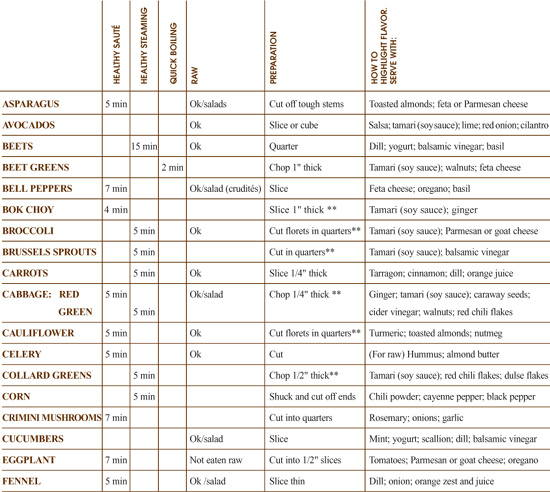
* Lycopene is concentrated in the skin, so if eating tomatoes raw, choose cherry tomatoes
** Let sit for 5–10 minutes before cooking
• All cooking times based on a medium-size vegetable.
• All vegetables can be served with Mediterranean dressing, except olives, corn, garlic and sea vegetables.
• Mediterranean Dressing: extra virgin olive oil, lemon, garlic, and sea salt and pepper to taste.
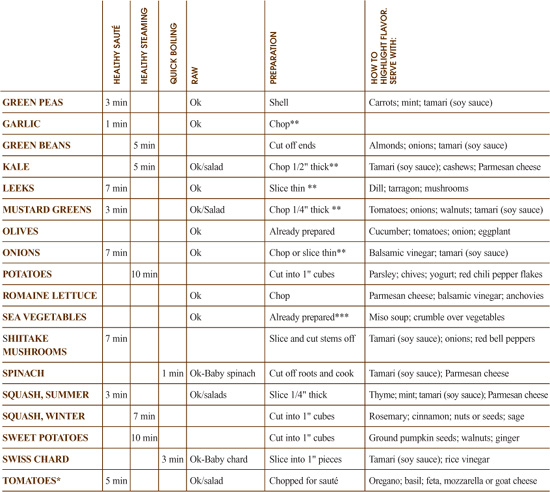
* Lycopene is concentrated in the skin, so if eating tomatoes raw, choose cherry tomatoes
** Let sit for 5–10 minutes before cooking
*** Follow directions on package
NOTE: YOU CAN COOK MORE THAN ONE VEGETABLE AT A TIME.

For more about the information above, see Mediterranean Feast, page 277.
HINT: To mellow the flavor of vegetables, sprinkle with a few drops of tamari (soy sauce) just before serving. Even kids will love them.
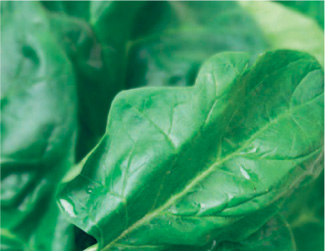
highlights

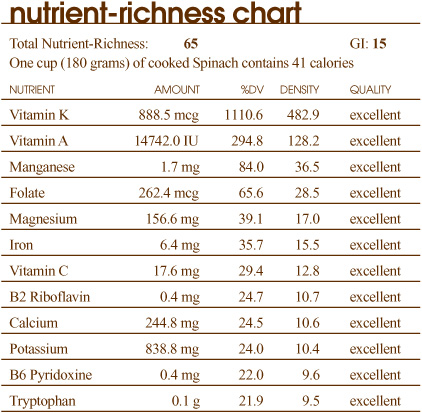
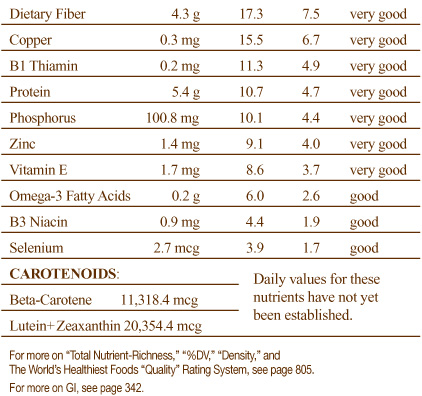
Spinach is a Mediterranean favorite that has been recognized as a distinctive vegetable since the Golden Age of the Renaissance back in the 16th century. When Catherine de Medici left her home in Florence, Italy, to marry the King of France, she brought cooks with her who knew how to prepare Spinach in the special way she loved best—the dish that has come to be known as Spinach a la Florentine. Now, you don’t need special cooks from Florence to prepare your Spinach. By using the al denté “Healthiest Way of Cooking,” you can bring out the best flavor from your Spinach while maximizing its nutritional value in just 1 minute.
It has been reported that the sale of Spinach has gone up 300% after it has become available prewashed and prepackaged.
Spinach is an excellent plant-based source of iron that, in comparison to meat sources, is low in calories and virtually fat-free. It is also a rich source of phytonutrients. Carotenoid phytonutrients such as betacarotene, lutein and zeaxanthin provide antioxidant protection against damage to cell structures. Spinach also contains at least 13 different flavonoid phytonutrients that also function as powerful antioxidants. Spinach is an ideal food to add to your “Healthiest Way of Eating” not only because it is so richly endowed with nutrients, but also because it is low in calories: one cup of cooked Spinach contains only 41 calories.
Overcooked and canned Spinach lose much of their nutrients as well as their beautiful rich green color. So, although we know Popeye made himself strong from eating Spinach, think how much stronger he would have been if he hadn’t eaten it out of a can! (For more on the Health Benefits of Spinach and a complete analysis of its content of over 60 nutrients, see page 104.)
Spinach (Spinacea oleracea) is thought to have originated in ancient Persia (Iran) and was introduced into China in the 7th century when the king of Nepal sent it as a gift to the emperor. Spinach shares a similar taste profile to Swiss chard and beet greens as they all belong to the same family of vegetables (known as “goosefoot” or Chenopodiaceae). Spinach can be enjoyed both cooked and raw. The varieties of Spinach are not identified at most markets; they are merely labeled as Spinach.
This is the most popular variety of Spinach and is used for cooking. It is the variety featured in the photographs in the this chapter. Curly Spinach is usually sold in bunches and requires thorough cleaning. It has crisp, curly leaves with the root end sometimes having a reddish coloration. Because of its firm texture, this variety is usually served cooked and is not the best choice to use raw in Spinach salads.
This variety is also served cooked. Its leaves are larger, smoother, more tender and sweeter than Curly Spinach; its stems are also more tender. Flat-leaf Spinach is similar in nutritional value to Curly Spinach.
Flat-leaf Spinach is often sold in bags with stems removed. Since there is little waste when using bagged Spinach, you will generally need to purchase less bagged Spinach than Spinach sold in bunches when following recipes calling for Spinach. Although it is prewashed, it is best to rinse before using.
This type of Spinach is best for salads and is too tender for cooking. Baby Spinach is immature Flat-leaf Spinach that has been harvested much earlier in its lifecycle. It has a mildly sweet flavor with very tender leaves and is lower in oxalic acid (data for specific amounts is not available). Baby Spinach is usually packaged in bags or sold in bulk with the stems included, but the stems are very tender and don’t need to be removed.
This native of New Zealand, Australia and Japan is not true Spinach but belongs to a different family called Aizoaceae and genus-species called Tetragonia tetragoniaides. It can be cooked in much the same way as true Spinach, is comparable in its vitamin C content and contains oxalic acid, but has slightly less betacarotene.
Frozen Spinach is very popular. It has been well-cleaned and precooked (blanched), so all you have to do is heat it thoroughly, or just defrost it in the refrigerator if you are going to add it to a recipe. Although it is nutritionally comparable to fresh cooked Spinach, it has less flavor.
Spinach is available throughout the year, but its flavor is at its peak during the cold months when the frost helps to develop a sweet flavor and crisp texture. In hotter months Spinach is less tender and will require around 30 seconds additional cooking time. The flavor of Baby Spinach does not vary throughout the year as it is harvested when it is very young.
Spinach is a highly concentrated source of oxalates, which might be of concern to certain individuals. It is one of the foods most commonly associated with allergic reactions in individuals with latex allergies. Spinach is one of the 12 foods on which pesticide residues have been most frequently found. (For more on: Oxalates, see page 725; Latex Food Allergies, see page 722; and Pesticide Residues, see page 726.)
Turning Spinach into a flavorful dish with the most nutrients is simple if you just follow my 4 easy steps:
1. The Best Way to Select
2. The Best Way to Store
3. The Best Way to Prepare
4. The Healthiest Way of Cooking
1. the best way to select spinach
You can select the best tasting Spinach by looking for vibrant, bright green leaves with stems that look fresh and crisp. By selecting the best tasting Spinach, you will also enjoy Spinach with the highest nutritional value. As with all vegetables, I recommend selecting organically grown varieties whenever possible. (For more on Organic Foods, see page 113.)
Avoid Spinach that shows signs of yellowing or that has leaves that are wilted or bruised. A slimy coating on Spinach leaves is an indication of decay.
2. the best way to store spinach
Spinach is a delicate vegetable. Be sure to store it properly or else it can lose up to 30% of some of its vitamins as well as much of its flavor.
Spinach continues to respire even after it has been harvested; its respiration rate at room temperature (68°F/20°C) is 230 mg/kg/hr. Slowing down the respiration rate with proper storage is the key to extending its flavor and nutritional benefits. (For a Comparison of Respiration Rates for different vegetables, see page 91.)
1. Store Spinach in the refrigerator. The colder temperature will slow the respiration rate, helping to preserve its nutrients and keep Spinach fresh for a longer period of time.
2. Place Spinach in a plastic storage bag before refrigerating. I have found that it is best to wrap the bag tightly around the Spinach, squeezing out as much of the air from the bag as possible.
3. Do not wash Spinach before refrigeration because exposure to water will encourage Spinach to spoil.
3. the best way to prepare spinach
Properly cleaning and cutting Spinach helps ensure that the Spinach you serve will have the best flavor and retain the greatest number of nutrients.
Spinach sold in bunches can often contain a large amount of soil and should be washed well. Before cleaning, reserve as much of the stem portion of the Spinach as possible by cutting only 1–2 inches off of the root end of the Spinach. You can save time by doing this in one cut before separating the bundle. Discard the outer leaves that may be tough, brown or slimy.
Place the Spinach in a large bowl of tepid water and swish the leaves around with your hands, dislodging as much of the soil as possible. To preserve nutrients, do not leave Spinach soaking or the water-soluble nutrients will leach into the water. Remove the leaves from the water, refill the bowl with fresh water and repeat this process until there is no longer any soil appearing in the water. Alternatively, once you have done this a couple of times, you can rinse it in a colander to remove any remaining soil. (For more on Washing Vegetables, see page 92.)
Spinach sold in bags has been pre-washed and only needs to be rinsed.
Spinach stems are good to eat and add extra enjoyment to your “Healthiest Way of Eating.” They are usually small and tender and can be cooked along with the leaves. They give balance of flavor and texture. You may occasionally find stems that are larger and tougher than usual and require extra cooking. In this case, separate the stems from the leaves. If you would like, you can then cook them for 1–2 minutes before adding the leaves; however, I have never found it necessary to cook them separately.
4. the healthiest way of cooking spinach
Since research has shown that important nutrients can be lost or destroyed by the way a food is cooked, the “Healthiest Way of Cooking” Spinach is focused on enhancing its flavor while maximizing its vitamins, minerals and powerful antioxidants.
In my search to find the Healthiest Way to cook Spinach, I tested every possible cooking method, and discovered that “Quick Boiling” Curly or Flat-leaf Spinach for just 1 minute produced the best result. Although 1 minute may seem like an extremely short time, I found that this is all it needs because it is a very delicate vegetable. “Quick Boiling” reduces the acids found in Spinach, brings out its mild, sweet, distinctive flavor, retains its bright green color and maximizes its nutritional profile. The Step-by-Step Recipe will show you how easy it is to “Quick Boil” Spinach.
In Mediterranean countries, where Spinach is very popular, it is usually cooked uncovered in a pot of boiling water. “Quick Boiling” is the healthiest way to cook Spinach because it frees up some of the unwanted acids and allows them to leach out into the water. While boiling is not considered the best way of cooking most vegetables, Spinach is one of only three vegetables I recommend boiling because of its acid content. The other two are Swiss chard and beet greens, which belong to the same botanical family as Spinach. After boiling any of these three vegetables, be sure to discard the cooking water. Do not drink it or use it for stock because it will contain the unwanted acids leached from the vegetables. (For more on “Quick Boiling,” see page 61.)
One of the primary reasons that cooked Spinach loses its flavor and shrinks up to 80% is because it is overcooked. That is why I recommend you “Quick Boil” Spinach al denté for the best flavor. Spinach cooked al denté is tender because it is cooked just long enough to soften its cellulose and hemicellulose fibers; this makes it easier to digest and allows its health-promoting nutrients to become more readily available for absorption. Remember that testing Spinach with a fork is not an effective way to determine whether it is done.
Spinach is a delicate vegetable, so it is very important not to overcook it. Spinach cooked for as little as a minute longer than al denté will begin to lose its chlorophyll and its bright green color; it will take on a brownish hue, a sign that magnesium is being lost. Overcooking Spinach will cause it to become soft and mushy and significantly decrease its nutritional value: as much as 50% of some nutrients can be lost. (For more on Al Denté, see page 92.)
I don’t recommend steaming Spinach because I find steamed Spinach has a slightly bitter acid taste since it is not able to release as much of the acids as it does when it is boiled. It is best not to sauté because Spinach does not contain enough liquid to extract and reduce Spinach’s acid concentration. (For more information on Oxalates, see page 725.) I also don’t recommend cooking Spinach in oil because high-temperature heat can damage delicate oils and potentially create harmful free radicals.
Traveling through the Mediterranean region, I found that Spinach was prepared in many different ways:
In Italy, they serve Spinach with pine nuts and raisins or anchovies.
In Greece, it is cooked with rice, feta cheese and mint.
In Spain, it is cooked with garlic, onion, paprika, olive oil, vinegar and cinnamon.
In North Africa, Spinach is made spicy with the addition of chili peppers, black pepper, cumin and garlic. They also add eggs, olive oil, tomato paste and lemon juice.
In France, it is served with pine nuts, garlic and nutmeg.
In Turkey, it is made into an appetizer called burek, a filled pastry.
Q I have heard that although Spinach is high in calcium, it also contains oxalates (oxalic acid) which block the calcium from being absorbed. Is there any truth to this?
A Spinach does contain calcium as well as oxalates. However, in every peer-reviewed research study I’ve seen, the ability of oxalates to lower calcium absorption definitely exists, but is relatively small, and definitely does not outweigh the ability of oxalate-containing foods to contribute calcium to the “Healthiest Way of Eating.” This relationship seems particularly true in the case of Spinach, which is incredibly calcium-rich (a cup of boiled Spinach contains over 240 mg). So while it’s true that Spinach is a relatively high oxalate food, and equally true that oxalates can bind with calcium and lower its absorption, the research does not seem to support the position that Spinach is a poor choice for increasing calcium in the “Healthiest Way of Eating.”
If you are still concerned about oxalates, cooking Spinach would actually be a way to reduce its oxalate content—by 5–15%—if it is cooked correctly. I recommend boiling Spinach without the top on the pot because this allows some of the oxalic acids to be liberated and therefore reduces the oxalate content of the Spinach. If you want to eat raw Spinach, use baby Spinach. Not only does baby Spinach have a sweeter flavor making it better suited for salads and other dishes where raw Spinach is called for, but it also has a lower oxalate content than mature Spinach.
STEP-BY-STEP RECIPE
The Healthiest Way of Cooking Spinach
Cooked Spinach is an excellent source of iron. Boosting iron stores with Spinach is a good idea, especially because in comparison to red meat—a well-known source of iron—Spinach provides iron for a lot less calories and is virtually fat-free. Iron is an integral component of hemoglobin, which transports oxygen from the lungs to all body cells, and is also part of key enzyme systems for energy production and metabolism.
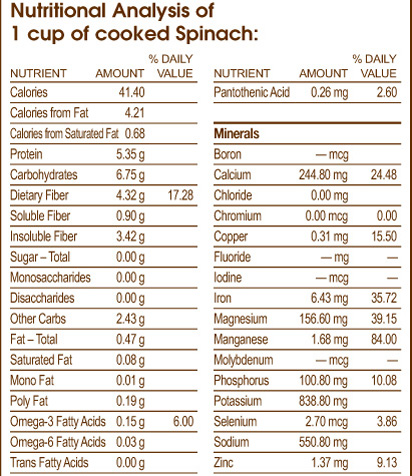
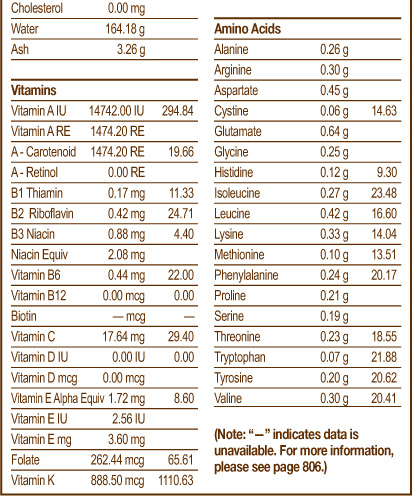
Researchers have identified at least 13 different flavonoid compounds in Spinach that function as antioxidants and as anticancer agents. (Many of these substances fall into a technical category of flavonoids known as methylene-dioxyflavonol glucuronides.) The anticancer properties of these Spinach flavonoids have been sufficiently impressive to prompt researchers to create specialized Spinach extracts that could be used in controlled studies. These Spinach extracts have been shown to slow down cell division in stomach cancer cells, and in studies with laboratory animals, to reduce skin cancers. A study on adult women also showed intake of Spinach to be inversely related to incidence of breast cancer. Spinach’s chemoprotective potential may also come from its concentration of carotenoid phytonutrients; carotenoid-rich diets have been found to be associated with a reduced risk of various types of cancer. A recent study just found that a novel carotenoid, neoxanthin, found in Spinach and other leafy vegetables, not only instructs prostate cancer cells to self-destruct but is also transformed into other molecules that prevent the cancer cells’ replication.
For atherosclerosis and diabetic heart disease, few foods compare to Spinach in their number of helpful nutrients. Spinach is an excellent source of vitamin C and vitamin A, the latter notably through Spinach’s concentration of betacarotene. These two nutrients are important antioxidants that work to reduce the amount of free radicals in the body; vitamin C works as a water-soluble antioxidant and betacarotene as a fat-soluble one. This water-and fat-soluble antioxidant team helps to prevent cholesterol from becoming oxidized, which can lead to the development of atherosclerosis. Spinach is also an excellent source of folic acid and vitamin B6, two B vitamins that help to keep homocysteine levels from becoming elevated. Homocysteine can directly damage artery walls and is a known risk factor for cardiovascular disease. Spinach is also an excellent source of magnesium and potassium, two minerals important for keeping blood pressure balanced.
In addition to its hefty supply of cardioprotective vitamins and minerals, a recent study revealed that an enzyme in Spinach contains protein components that inhibit angiotensin I-converting enzyme—the same enzyme blocked by ACE inhibitor drugs, which are used to lower blood pressure. When given to laboratory animals bred to be hypertensive, Spinach produced a blood pressure lowering effect within two to four hours.
In animal studies, researchers have found that Spinach may help protect the brain from oxidative stress and may reduce the effects of age-related declines in brain function. Researchers found that feeding aging laboratory animals Spinach-rich diets significantly improved both their learning capacity and motor skills.
In addition to being an excellent source of vitamin A, known as an important nutrient for eye health, Spinach is also one of the most concentrated sources of lutein and zeaxanthin, antioxidants suggested to play a very important role in promoting eye health. These carotenoid phytonutrients are thought to protect the eye from oxidative damage as well as promote the healthy distribution of epithelial tissue in the eye. Individuals who consume lutein/zeaxanthin-rich diets have been found to be at a lower risk for developing cataracts and age-related macular degeneration. Recent research has found that since these carotenoids are fat-soluble, consuming Spinach with some oil or fat-containing food like eggs or nuts may help to boost absorption of these important nutrients.
Spinach is also a concentrated source of other nutrients providing additional health-promoting benefits. These nutrients include free-radical-scavenging manganese, copper, zinc, vitamin E and selenium; energy-producing vitamin B1, B2 and niacin; bone-building calcium and phosphorus; digestive-health-promoting dietary fiber; muscle-building protein; inflammation-reducing omega-3 fatty acids; and sleep-promoting tryptophan. Since Spinach contains only 41 calories per one cup serving, it is an ideal food for healthy weight control.
Thorough washing of contaminated spinach cannot remove E. coli 0157:H7. According to the latest update statement issued by the U.S. Food and Drug Administration (FDA) on October 20, 2006, “Cooking fresh spinach at 160°F (71°C) for 15 seconds will kill any E. coli 0157:H7 present.” The cooking method we recommend on our website for spinach—a quick boil for approximately 1 minute—greatly exceeds this safety standard.
Is certified organic spinach an option here? While we certainly cannot call it a foolproof option, there’s definitely less chance of finding E. coli 0157:H7 bacteria in organically grown spinach than in conventionally grown spinach. The reason involves use of raw animal manure, which can be used at any time in the production of conventionally grown spinach. However, in the production of organically grown spinach, raw animal manure cannot be used less than 120 days prior to harvest if the food (like spinach) has an edible portion that comes into contact with the soil or soil surface. These restrictions on the use of raw animal manure help prevent crops like spinach from being contaminated with bacteria like E. coli 0157:H7.
Here is a question that I received from a reader of the whfoods.org website about Spinach:
Q Is there a difference nutritionally between raw and cooked Spinach? How about between regular size and Baby Spinach?
A There is little difference in the nutritional value between raw and cooked Spinach when “Quick Boiled” as I recommend since it is cooked for only a minute, and so there is little loss in vitamin content. However, Spinach is among a small number of foods that contain any measurable amount of oxalic acid, and cooking can help to reduce the oxalic acid content. This may be of importance to those who are sensitive to this compound, including those with certain kidney or gallbladder problems. If you do not have any of these health concerns, eating raw Spinach should present no problem.
When I want to enjoy Spinach raw, I usually choose Baby Spinach. From my understanding, Baby Spinach has a similar nutritional profile to regular Spinach, with one significant difference—it is lower in oxalic acid. Not only is this helpful to individuals concerned about intake of this compound, but the reduced acid content gives Baby Spinach a much sweeter taste. I also prefer the texture of raw Baby Spinach—it is more delicate and less chalky than mature Spinach. It also makes a nice presentation in salads because you can see the whole leaf compared to just a cut part of the leaf.
Baby Spinach is so convenient to use since it is widely available prewashed in bags at the grocery store. Using pre-washed Spinach can really cut down the time it takes to prepare a quick and easy salad.
If you like Baby Spinach as I do, you’ll be happy to know that it is becoming easier to find at restaurants. More and more restaurants are offering Baby Spinach on their menus, whether it be as part of a side or entrée salad or as an offering on their salad bars.

highlights

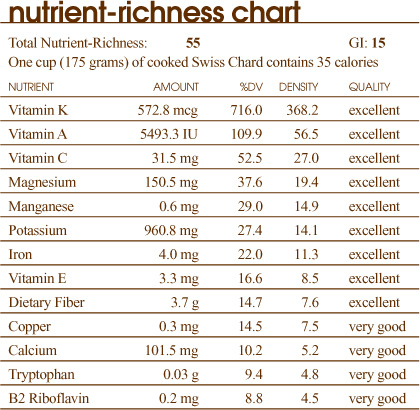
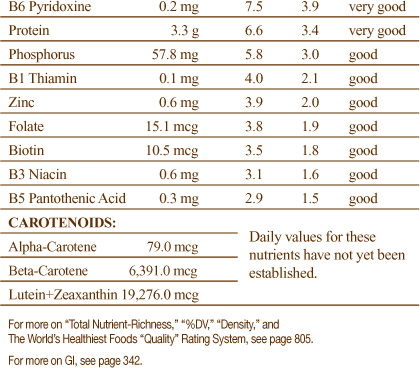
Swiss Chard has been renowned for its health-promoting properties since the time of the ancient Greeks and Romans. In fact, the Greek philosopher Aristotle wrote about Chard as early as the fourth century BC Swiss Chard is not native to Switzerland as its name might imply but was named by a 19th century Swiss botanist in honor of his homeland. While Chard remains one of the most popular vegetables in the Mediterranean region, it is still coming into its own in the United States. To help increase your appreciation for Swiss Chard, I want to share with you the “Healthiest Way of Cooking” al denté Chard. In just 3 minutes you can bring out its best flavor while maximizing the nutritional profile of this Mediterranean favorite. Its delicious, hearty flavor and many nutritional benefits make Swiss Chard a great substitute for spinach.
Calorie for calorie, Swiss Chard is one of the most nutritious vegetables around, featuring impressive concentrations of vitamins and minerals. Recent studies also show that Swiss Chard is a rich source of many newly discovered phytonutrients (plant nutrients). It is a concentrated source of carotenoids, such as betacarotene, lutein and zeaxanthin. These carotenoids, along with its flavonoid phytonutrients, including anthocyanins, provide powerful antioxidant protection. Research suggests that the high concentration of chlorophyll found in Swiss Chard is also health protective. Swiss Chard is an ideal food to add to your “Healthiest Way of Eating” not only because it is high in nutrients, but also because it is low in calories: one cup of cooked Swiss Chard contains only 35 calories. (For more on the Health Benefits of Swiss Chard and a complete analysis of its content of over 60 nutrients, see page 110.)
The term “Chard” describes a tall, leafy vegetable with a thick, crunchy stem to which wide, fan-like green leaves are attached. Swiss Chard (Beta vulgaris), along with kale, mustard greens and collard greens, are often referred to as “leafy greens,” and are among some of the most nutritious and health-promoting vegetables. Swiss Chard belongs to the same botanical family as beets and spinach. It is characterized by a bitter flavor with acidic undertones (due to its oxalic acid content), a full-bodied texture and an abundance of nutrients. Varieties of Swiss Chard can have either smooth or curly leaves with stems that are white, red, orange, purple, pink or yellow in color.
The stems of this variety come in a rainbow of colors such as white, red, orange, purple, magenta, pink and yellow. This is the most popular variety of Swiss Chard and is the one featured in the photographs in this chapter. The mixture of colors in Rainbow Chard provides a good balance of flavors, with white-stemmed and yellow-stemmed Swiss Chard having a milder flavor than those with red stems. The leaves are tender and sweet, and I recommend enjoying the white stems along with the leaves. The colored stems are not edible; the red stems are exceptionally tough.
This variety of Swiss Chard has crinkly leaves and is widely available. The white stems of this variety are tender, succulent and enjoyable to eat.
This yellow-stemmed variety has a more bitter flavor than white-stemmed Chard but less than red-stemmed Swiss Chard.
Slightly stronger tasting than the Fordhook variety, this is a crinkly-leafed Swiss Chard with thin stems. The stems of this red variety are too tough to eat.
This is immature Swiss Chard harvested early in its life cycle. Its small, mildly sweet, tender leaves are usually found in salad mixes and not sold on their own.
Silver Beet is a British/Australian term for Swiss Chard.
Swiss Chard is available throughout the year, but its flavor is at its peak during the cold months when the frost helps to develop a sweet flavor and crisp texture. In hotter months, Swiss Chard is less tender and will require 1–2 minutes additional cooking time.
Swiss Chard is a concentrated source of oxalates, which might be of concern to certain individuals. (For more on Oxalates, see page 725.)
Turning Swiss Chard into a flavorful dish with the most nutrients is simple if you just follow my 4 easy steps:
1. The Best Way to Select
2. The Best Way to Store
3. The Best Way to Prepare
4. The Healthiest Way of Cooking
1. the best way to select swiss chard
You can select the best tasting Swiss Chard by looking for leaves that have a vibrant, bright green color and crisp stems. I have found that Swiss Chard that has been stored in a chilled display has a crunchier texture and sweeter taste. By selecting the best tasting Swiss Chard, you will also enjoy the highest nutritional value. As with all vegetables, I recommend selecting organically grown varieties whenever possible. (For more on Organic Foods, see page 113.)
Avoid Swiss Chard with stems that are blemished or leaves that show signs of browning, yellowing, or wilting or that have tiny holes that may have been caused by insects.
2. the best way to store swiss chard
Swiss Chard is not as delicate as its cousin spinach; however, it will lose its freshness if not stored properly. If you are not planning to use Swiss Chard immediately after bringing it home from the market, be sure to store it properly or else it can lose up to 30% of some of its vitamins as well as much of its flavor.
Swiss Chard continues to respire even after it has been harvested. Slowing down the respiration rate with proper storage is the key to extending its flavor and nutritional benefits. (For a Comparison of Respiration Rates for different vegetables, see page 91.)
1. Store Swiss Chard in the refrigerator. The colder temperature will slow the respiration rate, helping to preserve its nutrients and keep Swiss Chard fresh for a longer period of time.
2. Place Swiss Chard in a plastic storage bag before refrigerating. I have found that it is best to wrap the bag tightly around the Swiss Chard, squeezing out as much of the air from the bag as possible.
3. Do not wash Swiss Chard before refrigeration because exposure to water will encourage Swiss Chard to spoil.
3. the best way to prepare swiss chard
Properly cleaning and cutting Swiss Chard helps to ensure that the Swiss Chard you serve will have the best flavor and retain the greatest number of nutrients.
It is best to rinse Swiss Chard under cold running water just before cutting. To preserve nutrients, do not soak Swiss Chard or the water-soluble nutrients will leach into the water. Remove any part of leaves that may be brown, slimy or have holes. (For more on Washing Vegetables, see page 92.)
In many parts of the world, Fordhook Swiss Chard (the type with white stems) is highly regarded with recipes created especially for its use. Unfortunately, most people in this country throw the stems away. I highly recommend enjoying the stems of Fordhook Chard together with the leaves because their flavors complement each other well. Stems from other varieties of Swiss Chard (especially those that are red) are tougher and not as succulent; I don’t recommend eating them.
Slicing Swiss Chard helps it to cook more quickly. The thinner you slice it, the more quickly it will cook. Stack the leaves and cut them into 1-inch slices until you reach the stems. If you are using Fordhook Chard, cut the stems into thinner slices (1/2inch). Discard the bottom inch of the stems.
Depending on their width, the stems may require longer cooking time than the leaves. If the stems are not over 1-inch wide, you can cook them together with the leaves for the same length of time. However, if the stems are wider than 1 inch, you may want to cook them for 2 minutes before adding the leaves.
4. the healthiest way of cooking swiss chard
Since research has shown that important nutrients can be lost or destroyed by the way a food is cooked, the “Healthiest Way of Cooking” Swiss Chard is focused on enhancing its best flavor while maximizing its retention of vitamins, minerals and powerful antioxidants.
In my search to find the healthiest way to cook Swiss Chard, I tested every possible cooking method and discovered that “Quick Boiling” all varieties of Swiss Chard (including Rainbow, Fordhook, Bright Yellow and Ruby Red) for just 3 minutes delivered the best result. “Quick Boiling” brings out the mild, sweet, distinctive flavor of Swiss Chard and retains its bright green color while maximizing its nutrient profile. The Step-by-Step Recipe will show you how easy it is to “Quick Boil” Swiss Chard.
“Quick Boiling” is the healthiest way to cook Swiss Chard because it frees up some of the unwanted acids and allows them to leach out into the water. I’ve observed that in Mediterranean countries, where Swiss Chard is very popular, it is cooked uncovered in a pot of boiling water. While boiling is not considered the best way of cooking most vegetables, Swiss Chard is one of only three vegetables I recommend boiling because of its acid content. The other two are spinach and beet greens. After boiling any of these three vegetables, be sure to discard the cooking water. Do not drink it or use it for stock because it will contain the unwanted acids leached from the vegetables. (For more on “Quick Boiling,” see page 61.)
One of the primary reasons for the loss of flavor when cooking Swiss Chard is overcooking. The traditional way of boiling Swiss Chard for 5–10 minutes, as is often recommended in cookbooks, is much too long. It not only destroys the color, flavor and texture of Swiss Chard, but most of its nutrients as well. That is why I recommend “Quick Boiling” Swiss Chard al denté for the best flavor. Swiss Chard cooked al denté is tender outside and slightly firm inside. Plus, Swiss Chard cooked al denté is cooked just long enough to soften its cellulose and hemicellulose fibers, which makes it easier to digest and allows its health-promoting nutrients to become more readily available for absorption. Remember that testing Swiss Chard with a fork is not an effective way to determine whether it is done.
Swiss Chard is a relatively delicate vegetable, so it is very important not to overcook it. Swiss Chard cooked for as little as a minute longer than al denté will begin to lose it chlorophyll and its bright green color; this is a sign that magnesium is being lost with the color of Swiss Chard slowly changing to a brownish hue. Overcooking Swiss Chard will cause it to become soft and mushy and significantly decrease its nutritional value: as much as 50% of some nutrients can be lost. (For more on Al Denté, see page 92.)
I don’t recommend steaming Swiss Chard because I find steamed Swiss Chard has a slightly bitter acid taste. This is because steaming does not immerse the Swiss Chard in water, which releases the acids. I also don’t recommend cooking Swiss Chard in oil because high-temperature heat can damage delicate oils and potentially create harmful free radicals.
Traveling through the Mediterranean region, I discovered that Swiss Chard is prepared in many different ways:
In Italy, both the stems and leaves of Swiss Chard are served with olive oil and tomatoes; it is also a popular addition to minestrone soup.
In Greece, Swiss Chard is prepared with leeks and dill.
In Spain, the stems and leaves of Swiss Chard are served with olive oil, garlic, pine nuts and raisins.
In Lebanon, Swiss Chard is served with hummus; the stems are used for dipping.
In France (especially in Nice, a city in the south of France, which is considered to be the Swiss Chard capital), the stems and leaves of Chard are incorporated into many dishes throughout the day. Even some French desserts contain Swiss Chard; one example is tourte de blettes, which is made with Swiss Chard, raisins, pine nuts, apples and eggs.
health benefits of swiss chard
Both the leaves and the roots of Swiss Chard have been the subject of fascinating health studies. Its combination of vitamins, minerals, phytonutrients (particularly anthocyanins), and dietary fiber may be protective in preventing digestive tract cancers. Several research studies on Swiss Chard have focused specifically on colon cancer, where the incidence of precancerous lesions in laboratory animals has been found to be significantly reduced following dietary intake of Swiss Chard extracts or fibers. Preliminary animal research also suggests that Swiss Chard may confer a protective effect on the kidneys of those with diabetes through reducing serum urea and creatinine levels.
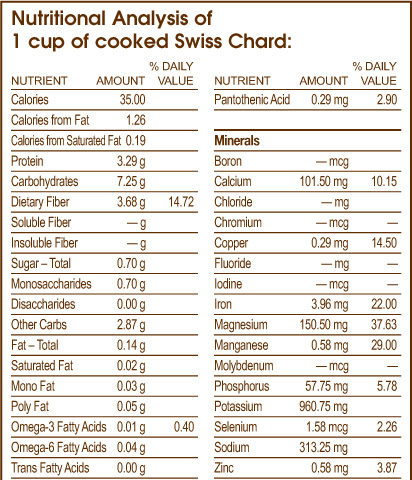
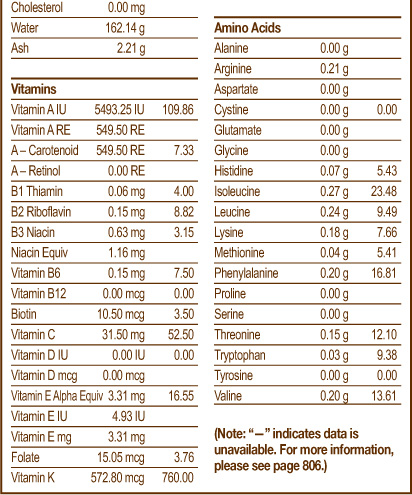
Swiss Chard is an excellent source of vitamin C, the primary water-soluble antioxidant in the body. Vitamin C disarms free radicals and prevents oxidative damage, including damage to DNA, which can lead to cancer. Especially in areas of the body where cellular turnover is especially rapid, such as the digestive system, preventing DNA mutations translates into preventing cancer. This is why a good intake of vitamin C is associated with a reduced risk of colon cancer.
Swiss Chard is also an excellent source of dietary fiber, which can bind to cancer-causing chemicals, keeping them away from the cells lining the colon, providing yet another line of protection from colon cancer. The fiber in Swiss Chard also provides bulk that helps to keep people “regular.”
Swiss Chard is a very good non-dairy source of calcium, a is an vates eral essential for optimal bone health. Swiss Chard o an excellent source of vitamin K, which also plays portant role in maintaining bone health since it acti-osteocalcin, the major non-collagen protein in bone. Magnesium, yet another nutrient of which Swiss Chard is an excellent source, is also necessary for healthy bones. About two-thirds of the magnesium in the human body is cal ound in our bones. Some helps give bones their physistructure, while the rest is found on the surface of the bone where it is stored by the body to be drawn upon as needed.
Swiss Chard is an excellent source of vitamin A because of its concentration of betacarotene. Once inside the body, betacarotene can be converted into vitamin A, so when you eat Swiss Chard, it’s like getting both of these beneficial nutrients at once.
Both vitamin A and betacarotene are important vision nutrients. In a study of over 50,000 women, those who consumed the highest dietary amount of vitamin A had a 39% reduced risk of developing cataracts.
Swiss Chard is also a concentrated source of the carotenoids lutein and zeaxanthin, which are pivotal eye health nutrients. Lutein and zeaxanthin are powerful antioxidants that protect the lens and retina from oxidative damage. Dietary intake of these carotenoids has been found to reduce risk of developing cataracts and age-related macular degeneration.
Swiss Chard is packed with nutrients that are good for your heart. Magnesium and potassium, two minerals of which Swiss Chard is an excellent source, are both important for regulating healthy blood pressure. One study found that men who ate diets higher in potassium-rich foods, as well as foods high in magnesium and fiber—also well provided by Swiss Chard—had a substantially reduced risk of stroke.
Swiss Chard is also a concentrated source of the ACE antioxidants—vitamin A, vitamin C and vitamin E. These nutrients help to protect cholesterol from being oxidized, therefore reducing its potential to form plaques that can lead to atherosclerosis and stroke.
Swiss Chard is an excellent source of iron, a mineral so vital to the health of the human body that it is found in every human cell. Iron is primarily linked with protein to form the oxygen-carrying molecule hemoglobin, which is why insufficient iron can quickly translate into anemia. Iron enhances oxygen distribution throughout your body, keeps your immune system healthy and helps your body produce energy. Swiss Chard is also an excellent source of manganese, which protects the energy-producing mitochondria in your cells from being damaged by free radicals. In addition, Swiss Chard is also a very good source of vitamin B2 and a good source of vitamin B1, vitamin B6, niacin, biotin and phosphorus, nutrients that are all necessary for energy production.
Swiss Chard is also a concentrated source of other nutrients providing additional health-promoting benefits. These nutrients include free-radical-scavenging copper and zinc, heart-healthy folic acid, muscle-building protein, and sleep-promoting tryptophan. Since cooked Swiss Chard contains only 35 calories per one cup serving, it is an ideal food for healthy weight control.
STEP-BY-STEP RECIPE
The Healthiest Way of Cooking Swiss Chard
Here are questions that I received from readers of the whfoods.org website about Swiss Chard, and weight-management, nutrient-rich foods and the immune system:
Q Swiss Chard is often referred to as having an acid-sweet taste. What kind of acid is in Swiss Chard?
A There are dozens of different organic acids, including carboxylic acids, which give Swiss Chard its delightful acidic bite. Additionally, Swiss Chard is a concentrated source of oxalic acid.
Q What is the relationship between weight-management, nutrient-rich foods and the immune system?
A Research and clinical observations suggest that obesity is associated with immune dysfunction. For example, increases in the incidence of infectious illness and infection-related mortality are found in obese people. An increase in inflammation has also been seen with an increase in weight in individuals. Some studies have shown an association between high cholesterol and susceptibility to infections as well. Therefore, maintaining a healthy weight and healthy cholesterol levels may also be beneficial to your immune system’s functioning.
Eating nutrient-rich whole foods is one way to provide your body with the full spectrum of nutrients it needs while keeping calorie intake to a healthy level. The World’s Healthiest Foods are analyzed for their nutrient-richness. Foods such as Swiss chard, crimini mushrooms, mustard greens, asparagus and romaine lettuce provide a broad spectrum of the key micronutrients that support healthy immune function and are therefore recommended as part of an immune-enhancing diet.
Organic refers to an “earth-friendly” and health-supportive method of farming and processing foods. Weeds and pests are controlled using environmentally sound practices that sustain our personal health and the health of our planet. Use of renewable resources is a key principle in all organic production. The term “organic” applies to both animal and plant foods.
Organically produced crops must be grown on land which has been free of prohibited substances for three years prior to harvest. The Organic Foods Production Act covers organic agricultural methods and materials in great detail, including management of soil fertility, when and how manure may be applied to crops, crop rotation and composting. Organic farmers do not use chemicals (pesticides, fungicides or fertilizers) in an environmentally harmful manner. In fact, most conventional pesticides and fertilizers are totally prohibited in the cultivation of organic food. Instead, a blend of old and new technologies and scientific research is used to avoid disrupting the earth’s natural ecosystem.
Examples of organic farming methods include:
• Rotating crops. By alternating crops from year to year on any given piece of land, it is possible for one type of crop to restore nutrients to the soil that another type of crop has removed. It is also possible to interrupt the growth cycle of microorganisms or pests like insects that might cause damage to crops.
• Planting select bushes and flowers to attract beneficial insects, which ward off unwanted pests.
Organic farming produces nutrient-rich, fertile soil, which nourishes the plant and keeps chemicals off the land to protect water quality and wildlife. Organic farming also gives us food that is safer to eat and much more likely to keep us healthy.
Quite simply, organic livestock must be fed organic feed. The National Organic Standards Board recommends that conventional feed be allowed only if the organic feed supply has been compromised by a national, state or local weather emergency, or by fire or flood on an organic farm. Growth promoters and hormones, and plastic pellets for roughage in feed are prohibited. Antibiotics, wormers and other medications may not be used routinely as preventive measures. Synthetic vitamins and minerals are allowed. Healthy living conditions and attentive care are considered first steps in the prevention of illness. Therefore, animals must not be overcrowded and must be allowed periodic access to the outdoors and direct sunlight.
The U.S. Department of Agriculture (USDA) sets, defines and regulates the use and meaning of “Organic” on food labels. It is the term used to describe raw or processed agricultural products and ingredients that have been (a) organically grown (farmed) and (b) handled in compliance with the standards of April 2001, which have been fully enforced since October 2002. These standards prohibit the use of:
• Most synthetic fertilizers and pesticides
• Sewer sludge fertilizers
• Genetic engineering
• Growth hormones
• Ionizing radiation (irradiation)
• Antibiotics
• Artificial ingredients
So, when you see foods that have the word “organic” on the packaging label, you can be assured that they meet these strict standards that were established for organic foods.
100% organic: A raw or processed agricultural product that contains (by weight or fluid volume, excluding water and salt) 100% organically produced ingredients.
Organic: A raw or processed agricultural product that contains (by weight or fluid volume, excluding water and salt) not less than 95% organically produced or organically processed agricultural products. Any time that the word “organic” is used to describe an entire product on the front of packaging, this requirement must be met.
Made with (specified) organic ingredients: A multi-ingredient agricultural product must contain at least 70% organically produced ingredients (by weight or fluid volume, excluding water and salt) that have been handled according to USDA organic standards. An example of this labeling requirement would be “Made with organic tomatoes.”
Organic ingredients listed individually: In a multi-ingredient agricultural product containing less than 70% organically produced ingredients, each organically produced ingredient can be identified as such on the side or back of the packaging; these ingredients cannot be advertised as organic on the front of the packaging.
USDA Organic Seal: The green USDA organics seal cannot be displayed on a product unless the 95% rule described above has been met.
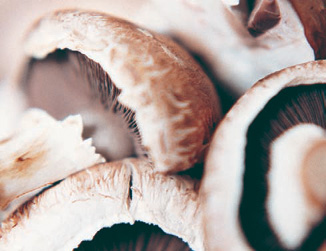
highlights

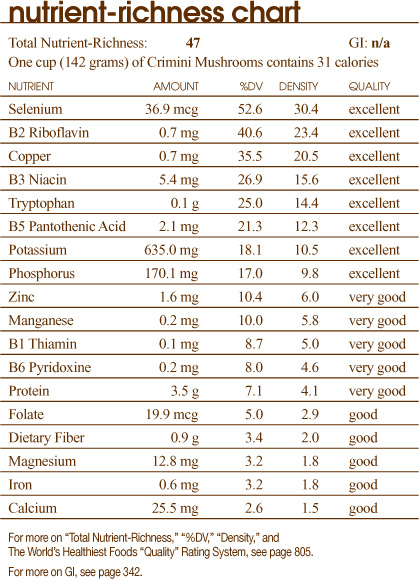
Ever since ancient times, people have thought of Mushrooms as being endowed with special powers. The Egyptians believed that they granted immortality, and since only the pharaohs were felt to be worthy of this gift, the common people were not even allowed to touch Mushrooms, let alone eat them. The ancient Romans described them as “foods of the Gods” and believed they were created by the lightning bolts thrown to Earth during thunderstorms by the god Jupiter. Mushrooms are delicious, and their natural umami flavor enhances the taste of any food with which they are cooked. Proper preparation of Crimini Mushrooms is the key to bringing out their best flavor and maximizing their nutritional benefits. That is why I want to share with you the secret of the “Healthiest Way of Cooking” Crimini Mushrooms. In just 7 minutes, you will have a dish that complements many of your favorite entrées.
Although Crimini Mushrooms are highly regarded as a side dish or salad addition, they are rarely acknowledged as a source of many health-promoting nutrients. Today, scientific research continues to discover why Mushrooms were once considered “food of the gods,” and the nutritional profile of Crimini Mushrooms clearly shows why they are included among the list of the World’s Healthiest Foods. Crimini Mushrooms have also been found to contain newly discovered, health-promoting polysaccharide phytonutrients, which function as powerful antioxidants, protecting against oxidative damage to cell structures and DNA. Crimini Mushrooms are an ideal food to add to your “Healthiest Way of Eating” not only because they are high in nutrients, but also because they are low in calories: one cup of Crimini Mushrooms contains only 31 calories. (For more on the Health Benefits of Crimini Mushrooms and a complete analysis of their content of over 60 nutrients, see page 118.)
Although Mushrooms are often considered a vegetable and are prepared like one, they are actually a fungus, a special type of living organism that has no roots, leaves, flowers or seeds. Crimini Mushrooms are one variety of button Mushrooms (Agaricus bisporus), which generally look like small cartoon umbrellas with a dense parasol-like cap attached to a stem that can be short and thick or thin and slightly curvy. Button Mushrooms have been growing wild since prehistoric times and were consumed as food by the early hunter-gatherers. Today, hunting for wild Mushrooms is a popular recreational activity, but you must be well informed and know which ones to pick as some types are poisonous.
Crimini Mushrooms look very similar in shape and size to the white Button Mushrooms commonly found at your local market, but they have a darker coffee color and a deeper “Mushroomy” flavor. Crimini Mushrooms are especially good for making stuffed Mushrooms. These are the Mushrooms featured in the photographs in this chapter.
The Portobello Mushroom, whose large size and meaty flavor make it a wonderful vegetarian entrée, is an overgrown Crimini Mushroom. They are especially good for grilling and roasting.
White Button Mushrooms are cousins of Crimini Mushrooms. These cream-colored Mushrooms are readily available, inexpensive and the variety most commonly found in markets. They are often served raw in salads and are especially good when combined with Crimini or Portobello Mushrooms.
Known as the “king of the wild Mushrooms” because of its popularity among wild Mushroom hunters, this Mushroom has a long, fleshy stalk and round, convex fleshy cap. Their distinguishing feature is the presence of vertical tube-like pores, instead of gills, on the underside of the cap. They have a woodsy aroma with a meaty texture and delicious flavor.
White, cream, yellow or reddish brown in color, they have a tender, velvety texture and mild flavor.
the peak season
available year-round.
Crimini mushrooms are a concentrated source of purines, which might be of concern to certain individuals. (For more on Purines, see page 727.)
Turning Crimini Mushrooms into a flavorful dish with the most nutrients is simple if you just follow my 4 easy steps:
1. The Best Way to Select
2. The Best Way to Store
3. The Best Way to Prepare
4. The Healthiest Way of Cooking
Here are questions I received from readers of the whfoods.org website about Crimini Mushrooms:
Q I eat a lot of Portobello Mushrooms and was wondering whether they are considered a healthy food. I love every type of Mushroom, but I recently heard that Mushrooms aren’t good for you.
A Portobello Mushrooms are actually overgrown Crimini Mushrooms, the brown Mushrooms readily available in supermarkets. Many people don’t realize this because they have such a unique flavor. Portobello Mushrooms’ size and flavor make them so versatile in cooking—they can be used as meat substitutes for sandwiches, fajitas and more. Just like the smaller Crimini Mushroom, they are incredibly rich in vitamins and minerals. In addition, they contain powerful phytonutrients, such as lentinan, which are suggested to protect our DNA from damage. So yes, I would say that Portobello Mushrooms are a very healthy food.
While there are a variety of different edible Mushrooms, there are also some wild Mushrooms that are toxic like those that you find wild in nature, those that you may come across during a hike. Unless you are with an experienced Mushroom forager, are absolutely certain about identification of Mushrooms, and know for sure which Mushrooms are safe to eat, it is always advised not to pick wild Mushrooms.
Q I currently live in the UK, and I have not been able to find Crimini Mushrooms in the stores. Is it possible that they are labeled with a different name?
A Crimini Mushrooms are a variety of the common button Mushroom but instead of being white or cream in color, they have a brownish tone to them. If you identify them this way to your local grocer, he or she may be better able to locate them for you. I have noticed the term “portobellini” Mushroom used in some areas in Europe, so if you see Mushrooms by this name, they may in fact be Criminis. This name undoubtedly is in reference to a small Portobello Mushroom, since Portobello Mushrooms are none other than overgrown Criminis.
1. the best way to select crimini mushrooms
You can select the best tasting Crimini Mushrooms by looking for Mushrooms that are firm, plump and clean. If your recipe calls only for Mushroom caps, you can avoid waste by selecting Mushrooms that have short stems.
Young Crimini Mushrooms that have been harvested before maturity have a membrane that extends from the edge of the cap to the stem covering the gills that line the underside of the cap. These Crimini Mushrooms have a delicate taste. As they are stored, the membrane will open exposing the gills. The gills become increasingly dark the longer the Crimini Mushrooms are stored. Crimini Mushrooms with dark gills have a deep, rich flavor but must be used right away. Their robust flavor makes them a good choice for making soups and sauces.
By selecting the best tasting Crimini Mushrooms, you will also be getting Mushrooms with the highest nutritional value. I recommend selecting organically grown Mushrooms whenever possible; however, they are not readily available. (For more on Organic Foods, see page 113.)
Avoid Crimini Mushrooms that are wrinkled or have wet slimy spots.
2. the best way to store crimini mushrooms
Crimini Mushrooms do not store well and lose their freshness quickly if not stored properly, which can result in their losing their flavor and up to 30% of some of their vitamins.
Crimini Mushrooms continue to respire even after they have been harvested; their respiration rate at room temperature (68°F/20°C) is 313 mg/kg/hr. Slowing down the respiration rate with proper storage is the key to extending their flavor and nutritional benefits. (For a Comparison of Respiration Rates for different vegetables, see page 91.)
1. Store Crimini Mushrooms in the refrigerator. The colder temperature will slow the respiration rate, helping to preserve their nutrients and keeping Crimini Mushrooms fresh for a longer period of time.
2. Unlike many other vegetables, Crimini Mushrooms should not be stored in a plastic storage bag since this does not allow them to respire well. Instead, place them in a paper bag, which will allow for optimal respiration.
3. Do not wash Crimini Mushrooms before refrigeration because exposure to water will encourage Crimini Mushrooms to spoil.
4. While loose Crimini Mushrooms will stay fresh for up to 5 days, those that are prepackaged will last longer, about 7–10 days before the package is opened. That is because most of these packages have been vacuum sealed.
Dried Mushrooms should be stored in a tightly sealed container in either the refrigerator or freezer where they will stay fresh for six months to one year.
3. the best way to prepare crimini mushrooms
Properly cleaning and cutting Crimini Mushrooms helps to ensure that the Mushrooms you serve will have the best flavor and retain the greatest number of nutrients.
Mushrooms are very porous and will quickly absorb water and become soggy if washed. The best way to clean Mushrooms, without sacrificing their texture and taste, is to clean them without water. To do this, simply wipe them well with a damp paper towel. You can also use a Mushroom brush, which you can find at most stores that sell kitchenware.
Cutting Mushrooms into equal size pieces will help them to cook more evenly. Since the smaller you cut them, the more quickly they will cook, I recommend cutting Mushrooms into quarters or slicing them. The stems are also edible, so slice off the stem tip, and slice the rest of the stem along with the cap.
Dried Mushrooms must be reconstituted. Place 1 ounce of dried Mushrooms in 1 cup of hot water for 30 minutes. Most of the flavor will end up in the liquid, so be sure to save and substitute it for other liquids in the recipe. To retain more of the flavor in the Mushrooms, soak in cold water overnight.
4. the healthiest way of cooking crimini mushrooms
Since research has shown that important nutrients can be lost or destroyed by the way a food is cooked, the “Healthiest Way of Cooking” Crimini Mushrooms is focused on bringing out their best flavor while maximizing their vitamins, minerals and powerful antioxidants.
In my search to find the healthiest way to cook Crimini Mushrooms, I tested every possible cooking method looking for the ways to bring out their best flavor and maximize the amount of their nutrients and discovered that “Healthy Sautéing” them for just 7 minutes delivered the best result. “Healthy Sautéed” Crimini Mushrooms are tender, have the best flavor and are extremely rich in nutrients. The Step-by-Step Recipe will show you how easy it is to “Healthy Sauté” Crimini Mushrooms. (For more on “Healthy Sauté,” see page 57.)
While grilled or broiled Crimini Mushrooms taste great, make sure they do not burn. It is best to grill Mushrooms on an area without a direct flame as the temperatures directly above or below the flame can reach as high as 500°F to 1000°F (260° to 538°C). When using a broiler, keep the Mushrooms about 4–5 inches away from the flame. Coating with olive oil before cooking will also produce harmful free radicals, so brush with extra virgin olive oil immediately after they are cooked. (For more on Grilling, see page 61.)
One of the primary reasons Crimini Mushrooms lose their flavor is because they are often overcooked. For the best flavor, I recommend “Healthy Sautéing” Crimini Mushrooms for 7 minutes. “Healthy Sautéed” Crimini Mushrooms are tender and cooked just long enough to soften their cellulose and hemicellulose fiber; this makes them easier to digest and allows their health-promoting nutrients to become more readily available for absorption.
Crimini Mushrooms cooked for as little as a couple of minutes longer than the recommended cooking time will begin to lose not only their texture and flavor, but also their nutrients. Overcooking Crimini Mushrooms will significantly decrease their nutritional value: as much as 50% of some nutrients can be lost.
I do not recommend boiling or steaming Crimini Mushrooms because these methods cause the Mushrooms to become watery and lose much of their flavor along with many of their nutrients; these include minerals, water-soluble vitamins (such as C and the B-complex vitamins) and powerful antioxidants unique to fruits and vegetables. I also don’t recommend cooking Crimini Mushrooms in oil because high-temperature heat can damage delicate oils and potentially create harmful free radicals.
health benefits of crimini mushrooms
Preliminary research suggests that Crimini Mushrooms may be an important food in a diet that is geared towards protecting against cancer. Extracts of Crimini Mushrooms have been found to protect DNA from oxidative damage; oxygen radicals attacking our genetic material is a cause of mutations that can lead to cancer development. In addition, these Mushrooms may prevent circulating levels of estrogen in the body from becoming excessive by inhibiting the aromatase enzyme; excessive estrogen can spark the development of breast cancer in certain women.
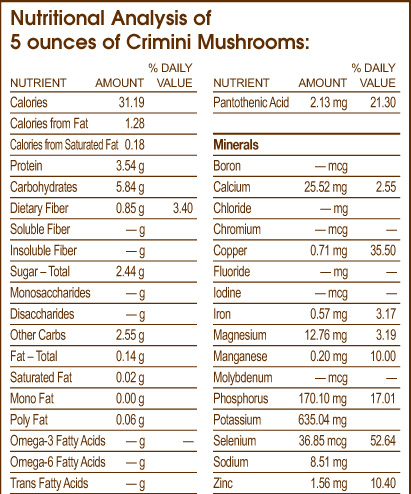
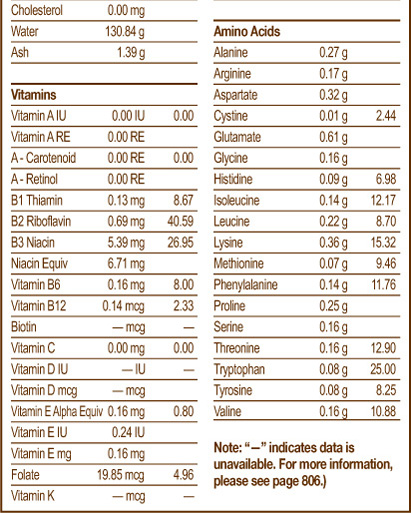
Crimini Mushrooms’ ability to promote optimal health may come not only from their powerful lentinan phytonutrients, but also from their impressive array of antioxidant minerals, including selenium of which they are an excellent source. Selenium is a necessary cofactor of one of the body’s most important internally produced antioxidants, glutathione peroxidase and also works with vitamin E in numerous vital antioxidant systems throughout the body. Selenium is involved in DNA repair, which is yet another way in which adequate intake of this mineral is associated with a reduced risk for cancer.
Crimini Mushrooms are an excellent source of riboflavin, pantothenic acid and niacin, as well as a very good source of thiamin and vitamin B6, and a good source of folic acid; all of these B vitamins are necessary for carbohydrate, protein and lipid metabolism.
Riboflavin (vitamin B2) plays at least two important roles in the body’s production of energy. It is part of a molecule that allows oxygen-based energy production to occur. It is also necessary for the recycling of glutathione, an antioxidant that protects the energy-producing mitochondria from oxidative damage.
Pantothenic acid (vitamin B5) also plays an important role in the prevention of fatigue since it supports the function of the adrenal glands, particularly in times of stress. Niacin (vitamin B3) is necessary for the conversion of the body’s proteins, fats and carbohydrates into usable energy.
Crimini Mushrooms are also a concentrated source of other nutrients providing additional health-promoting benefits. These nutrients include free-radical-scavenging zinc, copper and manganese; heart-healthy dietary fiber, magnesium and potassium; energy-producing iron; bone-building calcium and phosphorus; muscle-building protein; and sleep-promoting tryptophan. Since 5 ounces of raw Crimini Mushrooms contain only 31 calories, they are an ideal food for healthy weight control.
STEP-BY-STEP RECIPE
The Healthiest Way of Cooking Crimini Mushrooms
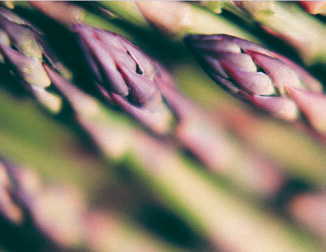
highlights

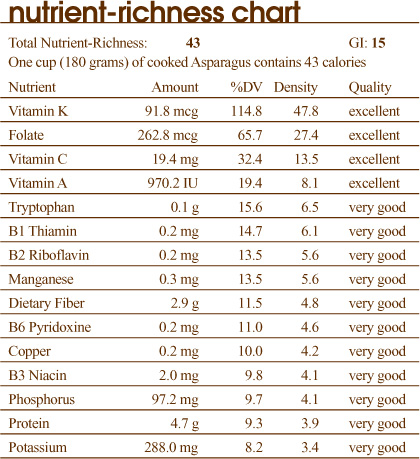

The appreciation for Asparagus’s delicious flavor, as well as its medicinal properties, goes as far back as the time of ancient Rome when fleets of ships were sent to gather Asparagus for the emperors. Perhaps, this is one of the reasons it is sometimes referred to as the “aristocrat of vegetables.” Today, this slender, succulent vegetable is available for you to enjoy without requiring the resources of an emperor. Because proper preparation is the key to enjoying the best flavor and the many health benefits of Asparagus, I want to share with you the secret of cooking Asparagus al denté using the “Healthiest Way of Cooking” method. In just 5 minutes, you will be able to enhance its flavor while maximizing its nutritional value.
Asparagus is renowned as an excellent source of folic acid, a B vitamin essential for proper cellular division and DNA synthesis as well as an essential nutrient for a healthy cardiovascular system. Asparagus also provides health-promoting carotenoid phytonutrients, such as betacarotene, lutein and zeaxanthin, which can function as powerful antioxidants that protect cells against the oxidative damage caused by free radicals. High in nutrients and low in calories, Asparagus is an ideal food to add to your “Healthiest Way of Eating” with one cup of cooked Asparagus containing only 43 calories. (For more on the Health Benefits of Asparagus and a complete analysis of its content of over 60 nutrients, see page 124.)
Asparagus (Asparagus officinalis) is an almost leafless perennial belonging to the lily family. The spears are the shoots of an underground crown. It takes up to three years for the crowns to begin producing the edible shoots, after which they will continue to produce for up to 20 years.
There are over 300 varieties of Asparagus, although only 20 are edible. These fall into three categories:
This variety is a delicately flavored, springtime favorite that grows to be about eight inches in height and is the type of Asparagus most commonly found in local markets. It is also the one featured in the photographs in this chapter.
White Asparagus is much more expensive than other varieties because of the labor required to produce it. The spears are kept covered and out of the sunlight while they are growing, which prevents the formation of chlorophyll that gives Green Asparagus its color. While White Asparagus is more tender than its green or purple counterparts, it is also less flavorful; however, some chefs prefer it to make their dishes more unique and special.
One to three inches in height, this variety is almost fiber-free, and some say it is best enjoyed raw. It cooks quickly, has a fruity flavor and provides additional health-promoting benefits from phytonutrients called anthocyanins that give it its purple color. The purple color will disappear with prolonged cooking.
The first Asparagus crops of the year are ready in California as early as February, with the peak of the season running from April through May. The growing season in the Midwest and East extends through July. These are the months when Asparagus’ concentration of nutrients and flavor are highest, and its cost is at its lowest. Although you can find imported Asparagus from South America in the fall and winter, it is more expensive then, and not as fresh as, locally grown varieties.
Asparagus is a concentrated source of purines, which might be of concern to certain individuals. (For more on Purines, see page 727.)
Turning Asparagus into a flavorful dish with the most nutrients is simple if you just follow my 4 easy steps:
1. The Best Way to Select
2. The Best Way to Store
3. The Best Way to Prepare
4. The Healthiest Way of Cooking
1. the best way to select asparagus
You can select green Asparagus with the best flavor and most nutrients by looking for spears that are firm with a bright green color and tips that are closed. As with all vegetables, I recommend selecting organically grown Asparagus whenever possible. (For more on Organic Foods, see page 113.)
Avoid yellowish spears that appear to be on the verge of flowering and those with stems that are dried out and cracked at the base or are wrinkled and feel hollow; that is because this usually indicates they are old and have begun to lose their nutritional value. I also always check that the Asparagus smells fresh and does not have a questionable odor.
I am often asked whether Asparagus is best when the shoots are small and thin or large and thick. I actually find that medium-size Asparagus (about 1/2inch in diameter, the thickness of your little finger) is the best. Very thin spears can be easily overcooked. Very thick spears are woody, tough and stringy and often require peeling and more time to prepare. If you are using thick-stemmed Asparagus, peel them and cut them in half lengthwise to help cook them in the recommended amount of time. Spears should be as uniform in size as possible so they will cook evenly.
2. the best way to store asparagus
Asparagus will become limp and decline in quality if not stored properly. Make sure to follow proper storage guidelines in order to preserve its flavor and nutrients (it can quickly lose up to 30% of some of its vitamins if not stored correctly).
Asparagus continues to respire even after it has been harvested; its respiration rate at room temperature (68°F/20°C) is 270 mg/kg/hr. Slowing down the respiration rate with proper storage is the key to extending its flavor and nutritional benefits. (For a Comparison of Respiration Rates for different vegetables, see page 91.)
1. Store fresh Asparagus in the refrigerator. The colder temperature will slow the respiration rate, helping to preserve its nutrients and keeping Asparagus fresh for a longer period of time.
2. Place Asparagus in a plastic storage bag before refrigerating. I have found that it is best to wrap the bag tightly around the Asparagus, squeezing out as much of the air from the bag as possible.
3. Do not wash Asparagus before refrigeration because exposure to water will encourage Asparagus to spoil.
3. the best way to prepare asparagus
Asparagus is very easy to prepare. Properly cleaning and cutting Asparagus will help ensure that the Asparagus you serve will have the best flavor and retain the greatest number of nutrients.
Rinse well under cold running water before cutting. (For more on Washing Vegetables, see page 92.)
Thin Asparagus does not require peeling. Asparagus with thick stems requires extra work to prepare. Thick Asparagus requires peeling because the stems are usually tough and stringy. Remove the tough outer skin of the bottom portion of the stem (not the tips) with a vegetable peeler.
You can have fun by snapping off the bottom of each individual stalk. They tend to break naturally where the woody portion of the spear ends and the tender part begins. This is usually where the color changes from white to green.
You can also remove the bottom part of all of the Asparagus stems at one time by cutting with a knife while the Asparagus is still in a bunch. You can use the tough woody ends to make broth for soup.
Thick Asparagus stems should be sliced in half lengthwise. This provides greater surface area, which will help it cook more quickly.
If you want to make limp Asparagus more crisp before cooking, cut off the woody ends and place the spears in a glass of ice water for a few minutes before you cook them.
4. the healthiest way of cooking asparagus
Since research has shown that important nutrients can be lost or destroyed by the way a food is cooked, the “Healthiest Way of Cooking” Asparagus is focused on bringing out its best flavor while maximizing its vitamins, minerals and powerful antioxidants.
In my search to find the healthiest way to cook Asparagus, I tested every possible cooking method and discovered that “Healthy Sautéing” Asparagus for just 5 minutes delivered the best result. “Healthy Sautéed” Asparagus has a mild, sweet flavor and has retained the maximum number of nutrients. I recommend using medium-size Asparagus because Asparagus with thick stems requires peeling, and very thin stems can be easily overcooked. Asparagus absorbs just enough moisture from the broth to make it tender. The Step-by-Step Recipe will show you how easy it is “Healthy Sauté” Asparagus. (For more on “Healthy Sauté,” see page 57.)
It takes virtually no time to grill or broil Asparagus. Before grilling or broiling, sprinkle with lemon, sea salt and pepper to help protect against the formation of harmful compounds. Grilling gives Asparagus a delicious sweet and smokey flavor. To make sure that it does not burn, be careful not to place the Asparagus too close to the flame. The temperatures directly above or below the flame can reach as high as 500°F to 1000°F (260° to 538°C). When using a broiler, keep it about 4–5 inches away from the flame. Coating with oil before cooking will produce harmful free radicals, so brush with extra virgin olive oil or your favorite vinaigrette right after it is cooked.
One of the primary reasons Asparagus loses its flavor is because it is often overcooked. For the best flavor, I recommend that you cook Asparagus al denté. Asparagus cooked al denté is tender outside and slightly crisp inside. Plus, Asparagus cooked al denté is cooked just long enough to soften its cellulose and hemicellulose, which makes it easier to digest and allows its health-promoting nutrients to become more readily available for absorption.
It is very important not to overcook Asparagus. Asparagus cooked for as little as a couple of minutes longer than al denté will begin to lose not only its texture and flavor, but also its nutrients. In purple varieties, you can see the purple color fade when it is overcooked, a reflection of the loss of its anthocyanin antioxidants. Overcooking Asparagus will significantly decrease its nutritional value: as much as 50% of some nutrients can be lost. (For more on Al Denté, see page 92.)
Boiling or steaming Asparagus increases its water absorption, causing it to become soggy and lose much of its flavor along with many of its nutrients; these include minerals, water-soluble vitamins (such as C and the B-complex vitamins) and health-promoting phytonutrients. Baked Asparagus gets mushy. I don’t recommend cooking Asparagus in oil because high-temperature heat can damage delicate oils and potentially create harmful free radicals.
Here is a question that I received from a reader of the whfoods.org website about Asparagus:
Q I heard that you should cook Asparagus in oil in order to retain its water-soluble nutrients and flavor. Is that true?
A While it is true that you will lose some water-soluble vitamins when cooking Asparagus in water, I don’t recommend cooking it in oil because heating oil can create undesirable free radicals that can compromise health. For more on Cooking with Oils, see page 52.
I have developed alternative methods to sautéing, a method that traditionally uses oil, by replacing the oil with broth. This “Healthy Sauté” method (page 57) is an excellent way to prepare Asparagus without the use of oil. It is quick and easy, and I believe that you will really enjoy the flavor and texture of Asparagus cooked this way.
As you point out, Asparagus, like other vegetables, contains water-soluble vitamins including vitamin C and the B vitamins. By “Healthy Sautéing,” for a short time you will lose no more than 5–10% of these vitamins and a minimal amount of minerals (less than 5%) while retaining the flavor and crispness of perfectly cooked Asparagus. This is because of the small amount of liquid used and the short cooking time.
Asparagus contains a special kind of carbohydrate called inulin that we don’t digest, but the health-promoting friendly bacteria in our large intestine do. When our diet contains good amounts of inulin, the growth and activity of these friendly bacteria increase. And when populations of health-promoting bacteria are large, it is much more difficult for unfriendly bacteria to gain a hold in our intestinal tract. Asparagus is also a very good source of dietary fiber, which promotes intestinal regularity and may help protect against the development of colon cancer.
Asparagus is a very good source of potassium and quite low in sodium. Its mineral profile, combined with the amino acid asparagine it contains, gives Asparagus a strong diuretic effect. Historically, Asparagus has been used to treat problems involving swelling, such as arthritis and rheumatism, and may also be useful for PMS-related water retention.
Asparagus is an excellent source of folic acid and a very good source of vitamin B6, nutrients essential for a healthy
cardiovascular system through their beneficial effect on homocysteine levels. When levels of these B vitamins are low, blood levels of homocysteine rise—a situation that significantly increases the risk for heart disease. Homocysteine promotes atherosclerosis by reducing the integrity of blood vessel walls and by interfering with the formation of collagen. Elevations in homocysteine are found in approximately 20–40% of patients with heart disease. It is estimated that consumption of 400 mcg of folic acid daily would reduce the number of heart attacks suffered by Americans each year by 10%. Asparagus is also rich in other heart-health-promoting nutrients, including dietary fiber, potassium, magnesium and calcium.
Especially if you’re thinking about becoming pregnant or are in the early stages of pregnancy, you may want to consider making Asparagus a frequent addition to your meals. That’s because the folic acid in Asparagus is essential for proper cellular division since it is necessary in DNA synthesis. Without folic acid, the fetus’ nervous system cells do not divide properly. Inadequate folic acid during pregnancy has been linked to several birth defects, including neural tube defects like spina bifida. Despite folic acid’s wide availability in food (its name comes from the Latin word folium, meaning “foliage,” because it’s found in green leafy vegetables), folic acid deficiency is the most common vitamin deficiency in the world.
Asparagus is also rich in bone-building nutrients. It is an excellent source of vitamin K and a good source of calcium and magnesium. In addition to its role in activating osteocalcin, which anchors calcium molecules inside of the bone, vitamin K is also important to maintaining proper blood coagulation.
Asparagus is a very good source of manganese, a trace mineral that is an essential cofactor of superoxide dismutase, an enzyme which disarms free radicals produced within the mitochondria and keeps energy production flowing. Asparagus is also a very good source of thiamin, riboflavin and niacin, three B vitamins that are essential for the conversion of the body’s proteins, fats and carbohydrates into usable energy. Asparagus is a very good source of phosphorus, which is an essential component of ATP, the fuel that cells use for energy. Additionally, it is also a good source of iron, a critical component of hemoglobin, a protein in blood that helps to transport oxygen throughout the body.
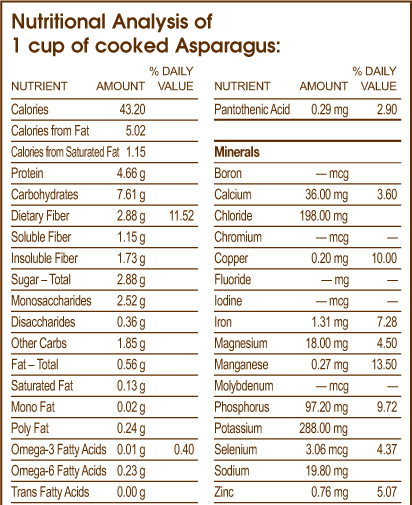
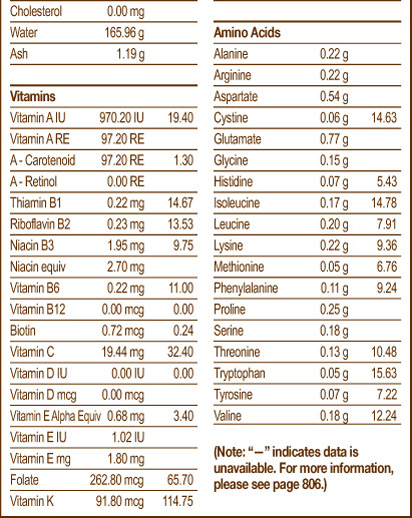
Asparagus is an excellent source of vitamin C and vitamin A (through its concentration of carotenoids) and a good source of zinc and selenium. These nutrients help promote optimal health through their potent antioxidant activity, protects cells from free radical oxidative damage. Uncontrolled free radical activity has been linked to increased risk of chronic degenerative diseases, including cardiovascular disease, arthritis and certain forms of cancer.
Asparagus is also a concentrated source of other nutrients providing additional health-promoting benefits. These nutrients include muscle-building protein, free-radical-scavenging copper and sleep-promoting tryptophan. Since Asparagus contains only 43 calories per one cup serving, it is an ideal food for healthy weight control.
STEP-BY-STEP RECIPE
The Healthiest Way of Cooking Asparagus
Here is a question that I received from a reader of the whfoods.org website about Asparagus:
Q Why do overcooked vegetables lose their bright green color?
One of the primary reasons for the change in color when green vegetables are cooked is the change in chlorophyll. Chlorophyll has a chemical structure that is quite similar to hemoglobin, which is found within our red blood cells. A basic difference is that chlorophyll contains magnesium at its center, while hemoglobin contains iron. When plants (e.g., green vegetables) are heated and/or exposed to acid, the magnesium gets removed from the center of this ring structure and replaced by an atom of hydrogen. In biochemical terms, the chlorophyll a gets turned into a molecule called pheophytin a, and the chlorophyll b gets turned into pheophytin b. With this one simple change, the color of the vegetable changes from bright green to olive-gray as the pheophytin a provides a green-gray color, and the pheophytin b provides an olive-green color. This color change is one of the reasons I have established the relatively short cooking times for green vegetables in the “Healthiest Way of Cooking” methods. These cooking methods are designed to preserve the unique concentrations of chlorophyll found in these vegetables.
Proof of their superiority has been demonstrated in numerous studies. In 1998, a review of 34 studies comparing the nutritional content of organic versus conventionally grown was published in the peer-reviewed, MEDLINE-indexed journal, Alternative Therapies (Vol. 4, No. 1, pgs. 58–69). In this review, organic food was found to have higher protein quality in all comparisons, higher levels of vitamin C in 58% of all studies and 5–20% higher mineral levels for all but two minerals. In some cases, the mineral levels were dramatically higher in organically grown foods—as much as three times higher in one study involving iron content.
Organic foods may also contain more flavonoids than conventionally grown foods, according to Danish research published in the August 2003 issue of the Journal of Agricultural and Food Chemistry. In this study, 16 healthy nonsmoking participants ranging in age from 21–35 years were given either a diet high in organically grown or conventionally grown fruits and vegetables for 22 days, after which they were switched over to the other diet for another 22 days. After both dietary trials, the researchers analyzed levels of flavonoids and other markers of antioxidant defenses in the food and in the participants’ blood and urine samples. Results indicated a significantly higher content of the flavonoid quercitin in the organic produce and in the subjects’ urine samples when on the organic produce diet; the subjects’ urinary levels of another flavonoid, kaempferol, were also much higher when on the organically grown diet compared to the conventionally grown diet.
A review of 41 studies comparing the nutritional value of organically grown to conventionally grown fruits, vegetables and grains also indicates organic crops provide substantially more of several nutrients, including:
• 27% more vitamin C
• 21% more iron
• 29% more magnesium
• 14% more phosphorus
The review also found that while five servings of organically grown vegetables (lettuce, spinach, carrots, potatoes and cabbage) provided the daily recommended intake of vitamin C for men and women, their conventionally grown counterparts did not. Plus, organically grown foods contained 15% less nitrates than conventionally grown foods. Nitrates, a major constituent of chemical fertilizers, bind to hemoglobin and, particularly in infants, can significantly reduce the body’s ability to carry oxygen.
In another study whose findings are based on pesticide residue data collected by the U.S. Department of Agriculture, organic fruits and vegetables were shown to have only one-third as many pesticide residues as their conventionally grown counterparts. Study data, which covered more than 94,000 food samples from more than 20 crops, showed 73% of conventionally grown foods sampled had residue from at least one pesticide, while only 23% of organically grown samples had any residues. More than 90% of USDA’s samples of conventionally grown apples, peaches, pears, strawberries and celery had residues.
When it comes to choosing between organic or conventionally grown foods, size is definitely not everything, suggests another study published in Science Daily Magazine. Chemistry professor Theo Clark and undergraduate students at Truman State University in Mississippi found organically grown oranges contained up to 30% more vitamin C than those grown conventionally. Reporting the results at the June 2, 2002, meeting of the American Chemical Society, Clark said he had expected the conventionally grown oranges, which were twice as large, to have twice the vitamin C as the organic versions. Instead, chemical isolation combined with nuclear magnetic resonance spectroscopy revealed the much higher level in organic oranges.
Why the big difference? Clark speculated that “with conventional oranges, (farmers) use nitrogen fertilizers that cause an uptake of more water, so it sort of dilutes the orange. You get a great big orange, but it is full of water and doesn’t have as much nutritional value.”
Eating organic may also help protect against chronic inflammation, a major factor in both cardiovascular disease and colon cancer. Another study, published in the European Journal of Nutrition, found that organic soups sold in the United Kingdom contain almost six times as much salicylic acid as non-organic soups. Salicylic acid, the compound responsible for the anti-inflammatory action of aspirin, has been shown to help prevent hardening of the arteries as well as bowel cancer. Researchers compared the salicylic acid content of 11 brands of organic soup to that found in non-organic varieties. The average level of salicylic acid in 11 brands of organic vegetable soup was 117 nanograms per gram, compared with 20 nanograms per gram in 24 types of non-organic soup. The highest level (1,040 nanograms per gram) was found in an organic carrot and coriander soup. Four of the conventional soups had no detectable levels of salicylic acid.
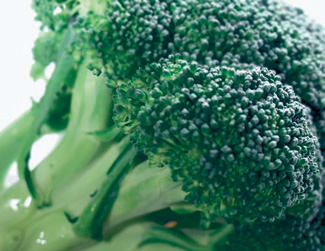
highlights

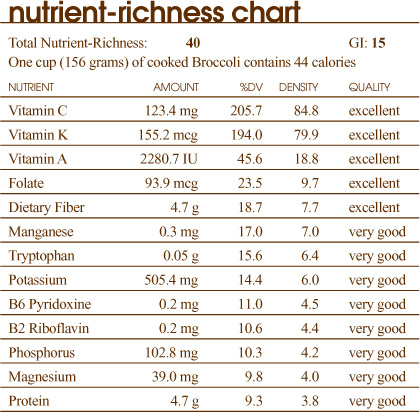
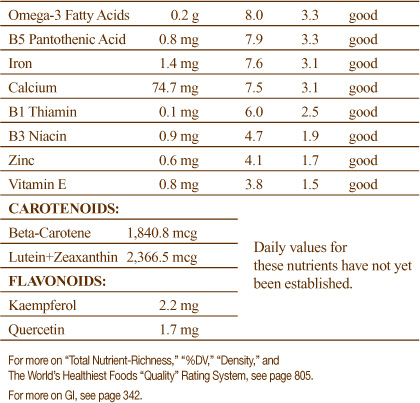
Broccoli originated in the Mediterranean region of Europe, and today is one of the most popular green vegetables in the United States because of its unique flavor and incredible nutritional value. It is one of those cruciferous vegetables that continues to make headlines as a super-food as more and more scientific research verifies its benefits. Proper preparation of Broccoli is the key to bringing out its best flavor and maximizing its nutritional benefits. That is why I want to share with you the secret of the “Healthiest Way of Cooking” Broccoli al denté. In just 5 minutes, you will be able to transform Broccoli into a flavorful vegetable while maximizing its nutritional value.
Scientific studies now show that cruciferous vegetables, like Broccoli, are included among the vegetables that contain the largest concentrations of health-promoting sulfur compounds, such as sulforaphane and isothiocyanates (see page 153), which increase the liver’s ability to produce enzymes that neutralize potentially toxic substances. Broccoli is also rich in the powerful phytonutrient antioxidants lutein and zeaxanthin, carotenoids that are concentrated in the lens of the eye. Along with vitamins A and C, which provide powerful antioxidant protection, Broccoli is a rich source of folic acid, an important nutrient for a healthy heart. Broccoli is an ideal food to add to your “Healthiest Way of Eating” not only because it is high in nutrients, but also because it is low in calories: one cup of cooked Broccoli contains only 44 calories. (For more on the Health Benefits of Broccoli and a complete analysis of its content of over 60 nutrients, see page 134.)
Broccoli is a member of the cruciferous (Brassica) family of vegetables that also includes cauliflower, kale, collard greens, cabbage, mustard greens and Brussels sprouts. Broccoli dates back to ancient Rome, when it was developed from wild Broccoli, a plant that resembled collard greens more than the Broccoli with which we are familiar today. Its name comes from the Italian word brachium, which means “branch.” Varieties of Broccoli include:
(ALSO KNOWN AS ITALIAN GREEN OR CALABRESE)
The most popular variety of Broccoli, this is the one most commonly found in your local market. It is the variety featured in the photographs in this chapter. Named after the Italian province of Calabria where it first grew, it has light green stalks topped with clusters of dark green, purplish florets.
A baby Broccoli that is a cross between Broccoli and kale, this is the best type of Broccoli to serve raw.
This is a cross between Broccoli and cauliflower, but it is more like cauliflower than Broccoli.
This variety has an intense flavor with pleasantly bitter and peppery highlights. Compared to Green Broccoli, it has more leaves and a longer stem. The stem is tender and does not need to be peeled, just cut into 1-inch thick slices and cook with the leaves and florets. Enjoy all but the bottom 2-inches of the stem, which is tough and woody and should be discarded. Broccoli Raab can be used in place of Green Broccoli in most recipes.
Sprouts from Broccoli seeds that have recently become popular for their high concentration of health-promoting phytonutrients (see page 153).
Broccoli is available throughout the year, but its flavor is at its peak during the cold months when the frost helps to develop a sweet flavor. In hotter months, Broccoli is less tender and will require around 1 minute additional cooking time.
Broccoli is a concentrated source of goitrogens, which might be of concern to certain individuals. (For more on Goitrogens, see page 721.)
Turning Broccoli into a flavorful dish with the most nutrients is simple if you just follow my 4 easy steps:
1. The Best Way to Select
2. The Best Way to Store
3. The Best Way to Prepare
4. The Healthiest Way of Cooking
Here is a question that I received from a reader of the whfoods.org website about Broccoli:
Q Which has more nutrients—the stems or florets of Broccoli?
A The florets and stems of Broccoli are very similar in their nutrient content. The amount of most B vitamins, minerals, and fiber is very similar in the two parts of the plant (on an ounce-for-ounce basis). The largest difference we’ve seen documented in the research literature involves betacarotene, which is about seven times more plentiful in the florets than in the stems. On an ounce-for-ounce basis, the darker green florets also contain more chlorophyll than the lighter green stalks. Stalks can take a little longer to steam than florets and should usually be started a little earlier in the steaming process for this reason.
Broccoli leaves are also excellent sources of nutrients. They are actually higher in betacarotene than the florets of the Broccoli plant, and they can contain other phytonutrients that aren’t found in the stems and florets.
1. the best way to select broccoli
You can select the best tasting Broccoli by looking for tightly closed floret clusters that are dark green or purplish in color. Dark green Broccoli contains more chlorophyll, betacarotene and vitamin C, while purple-colored heads of Broccoli contain higher concentrations of flavonoids. Stalks and stems should be firm, and the leaves should be attached, vibrant and not wilted. By selecting the best tasting Broccoli, you will also enjoy Broccoli with the highest nutritional value. As with all vegetables, I recommend selecting organically grown varieties whenever possible. (For more on Organic Foods, see page 113.)
Avoid Broccoli with florets that are not compact or uniformly colored. They should not be yellow, bruised or have yellow blossoms, an indication that they are overly mature. Do not purchase Broccoli with stalks that are too wide, woody or hollow, and be sure to check for areas that may be spoiled or have a sour smell.
2. the best way to store broccoli
If not stored properly, Broccoli will become limp, start to turn yellow and become bitter. If you are not going to enjoy Broccoli immediately after bringing it home from the market, be sure to store it properly to maintain its optimal flavor and nutrient concentration.
Broccoli continues to respire even after it has been harvested; its respiration rate at room temperature (68°F/20°C) is 300 mg/kg/hr. Slowing down the respiration rate with proper storage is the key to extending its flavor and nutritional benefits. (For a Comparison of Respiration Rates for different vegetables, see page 91.)
1. Store fresh Broccoli in the refrigerator. The colder temperature will slow the respiration rate, helping to preserve its nutrients and keeping Broccoli fresh for a longer period of time.
2. Place Broccoli in a plastic storage bag before refrigerating. I have found that it is best to wrap the bag tightly around the Broccoli, squeezing out as much of the air from the bag as possible.
3. Do not wash Broccoli before refrigeration because exposure to water will encourage Broccoli to spoil.
If you need to store a partial head of Broccoli, place it in a container with a well-sealed lid, or a plastic bag, and refrigerate. Since the vitamin C content starts to quickly degrade once the Broccoli has been cut, it is best to use the remainder within a couple of days.
3. the best way to prepare broccoli
I want to share with you the best way to prepare Broccoli. Properly cleaning and cutting Broccoli helps to ensure that the Broccoli you serve will have the best flavor and retain the greatest number of nutrients.
Before cutting Broccoli, rinse well under cold running water. To preserve nutrients, do not soak Broccoli or the water-soluble nutrients will leach into the water. (For more on Washing Vegetables, see page 92.)
Cutting Broccoli florets into equal size pieces will help them to cook more evenly. The smaller you cut the florets, the more quickly they will cook. I recommend cutting florets into quarters. Cutting florets into smaller pieces also helps maximize the formation of health-promoting compounds when you let them sit for 5 minutes before cooking.
I usually include the stems and leaves when I prepare Broccoli. They are not only nutritious and taste great, but you will also get more Broccoli for your money if you enjoy them along with the florets. Stems and leaves provide a good balance of flavors.
There are several ways to peel the Broccoli stem: (1) peel the entire stalk with a knife by beginning at the top of the stalk and removing long strips of the peel, similar to removing the string from celery; (2) remove the florets, cut the stems into shorter lengths and peel with a sharp knife by standing them on end and cutting downward to remove the tough outer skin; or (3) peel the Broccoli stems with a vegetable peeler.
Slice the stems into 1/4-inch slices, and cook both the stems and leaves along with the florets.
4. the healthiest way of cooking broccoli
Since research has shown that important nutrients can be lost or destroyed by the way a food is cooked, the “Healthiest Way of Cooking” Broccoli is focused on enhancing its best flavor while maximizing its vitamins, minerals and powerful antioxidants.
In my search to find the healthiest way to cook Broccoli, I tested every possible cooking method and discovered that “Healthy Steaming” all varieties of Broccoli for just 5 minutes delivered the best results. “Healthy Steaming” provides the moisture necessary to make Broccoli tender, bring out its peak flavor, retain its bright green color and maximize its nutritional profile. The Step-by-Step Recipe will show you how easy it is to “Healthy Steam” Broccoli. (For more on “Healthy Steaming,” see page 58.)
One of the primary reasons people do not enjoy Broccoli is because it is often overcooked. For the best flavor, I recommend cooking Broccoli al denté. Broccoli cooked al denté is tender outside and slightly crisp inside. Plus, Broccoli cooked al denté is cooked just long enough to soften its cellulose and hemicellulose fiber; this makes it easier to digest and allows its health-promoting nutrients to become more readily available for absorption.
Although Broccoli is a hearty vegetable, it is very important not to overcook it. Broccoli cooked for as little as a couple of minutes longer than al denté will begin to lose not only its texture and flavor but also its nutrients. Overcooking Broccoli will significantly decrease its nutritional value: as much as 50% of some nutrients can be lost. (For more on Al Denté, see page 92.)
Cutting Broccoli florets into quarters and cooking them al denté for only 5 minutes is my secret for preventing the formation of smelly compounds often associated with cooking Broccoli. When I cook my Broccoli, it never develops a strong smell. After 5 minutes of cooking, the texture of Broccoli, like all other cruciferous vegetables, begins to change, becoming increasingly soft and mushy. At this point, it also starts to lose more and more of its chlorophyll, causing its bright green color to fade and a brownish hue to appear. This is a sign that magnesium has been lost. This is when it starts to release hydrogen sulfide, the cause of the “rotten egg smell,” which also affects the flavor. After 7 minutes of cooking, Broccoli develops a more intense flavor, with the amount of strong smelling hydrogen sulfide doubling in quantity.
While it is important not to overcook Broccoli, cooking for less than 5 minutes is also not recommended because it takes about 5 minutes to soften its fibers and help increase its digestibility.
Boiling Broccoli increases its water absorption, causing it to become soggy and mushy. It then loses much of its flavor along with many of its nutrients, including minerals, water-soluble vitamins (such as C and the B-complex vitamins) and health-promoting phytonutrients. I don’t recommend baking, broiling, grilling or roasting Broccoli as they will cause it to dry up and shrivel. I don’t recommend cooking Broccoli in oil because heating oils to high temperatures can damage delicate oils and potentially create harmful free radicals.
Traveling through the Mediterranean region, I found Broccoli was prepared in many different ways:
In Italy, Broccoli is served with anchovies, onions or Romano cheese.
In Greece, Broccoli is served with grated cheese.
Here is a question I received from a reader of the whfoods.org website about Broccoli:
Q What are the special phytonutrients for which Broccoli and other cruciferous vegetables have become famous?
A Broccoli, and other cruciferous vegetables, are replete with a host of different phytonutrients that contribute to their amazing health-promoting potential. Included in these are carotenoids and flavonoids as well as sulfur-containing phytonutrients that have been garnering a lot of recent attention for their cancer-prevention properties. Included among these sulfur-containing nutrients are glucosinolate, indole-3-carbinol and a group classified by their chemical family name, isothiocyanates.
While some health researchers group glucosinolate, isothiocyanates and indole-3-carbinol together and call them “indoles,” only the latter actually fits that classification. (The term “indole” refers to a chemical structure that some compounds have, featuring two specifically shaped carbon rings with an attached amino group. Other well-known indoles include the amino acid tryptophan and the neurotransmitters serotonin and melatonin.) Since glucosinolate, isothiocyanates, and indole-3-carbinol are technically classified in different chemical families, I think that the best way to refer to them collectively is by calling them “sulfur-containing phytonutrients.”
STEP-BY-STEP RECIPE
The Healthiest Way of Cooking Broccoli
Like other cruciferous vegetables, Broccoli contains phytonutrients thought to have anticancer effects. One group of these phytonutrients are the isothiocyanates, with research on one of its members, indole-3-carbinol, showing that it helps deactivate a potent estrogen metabolite (4-hydroxyestrone) that promotes tumor growth, especially in estrogen-sensitive breast cells. Indole-3-carbinol has been shown to suppress not only breast tumor cell growth but also cancer cell metastasis (the movement of cancerous cells to other parts of the body). Broccoli also contains the phytonutrient glucoraphanin, which is converted into sulforaphane in the body. Scientists have found that sulforaphane boosts the liver’s detoxification enzymes, helping to clear potentially carcinogenic substances more quickly. Animal research suggests that sulforaphane may protect against tumor development by inducing cancer cell apoptosis (programmed cell suicide).
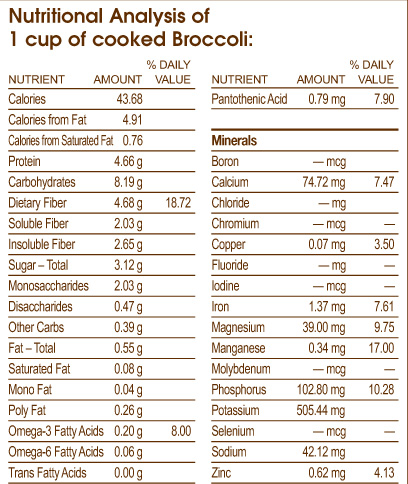
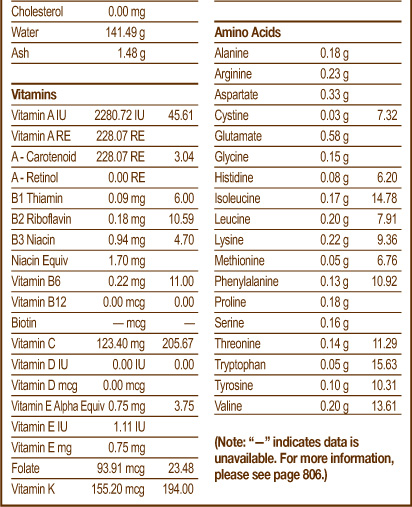
New research has uncovered another way Brassica family vegetables such as Broccoli may help prevent cancer. When these vegetables are cut, chewed or digested, a sulfur-containing compound called sinigrin is brought into contact with the enzyme myrosinase, resulting in the release of special compounds, including isothiocyanates. Not only are these sulfur-containing phytonutrients potent inducers of liver enzymes that detoxify carcinogens, but recent research shows one of these compounds, allyl isothicyanate, also inhibits cell division and stimulates apoptosis in human tumor cells.
Broccoli sprouts definitely prove the adage, “Good things come in small packages.” Broccoli sprouts concentrate phytonutrients found in mature Broccoli; researchers estimate that Broccoli sprouts contain 10–100 times the power of mature Broccoli to boost enzymes that detoxify potential carcinogens!
Broccoli has been singled out as one of the small number of vegetables and fruits that contributed to the significant reduction in heart disease risk seen in a recent meta-analy-sis of seven prospective studies. Of the more than 100,000 individuals who participated in these studies, those whose diets most frequently included Broccoli, onions, apples and tea—the richest sources of flavonoids, such as quercetin—experienced a 20% reduction in their risk of heart disease. Animal studies suggest that eating Broccoli sprouts may also have a beneficial effect since their concentration of the phytonutrient glucoraphanin helps to quench free radicals and allay the inflammation that contributes to cardiovascular problems. In addition, Broccoli is a concentrated source of many other heart-healthy nutrients including dietary fiber, folic acid, vitamin B6, vitamin E, niacin, magnesium, potassium and omega-3 fatty acids.
Research suggests that the phytonutrients contained in Broccoli and Broccoli sprouts may eradicate Helicobacter pylori, the bacterium not only responsible for most peptic ulcers but one that has also been found to increase a person’s risk of getting stomach cancer three to six-fold. In a recent animal study, sulforaphane completely eliminated H. pylori in 8 of 11 laboratory animals infected with bacterium. A follow-up human study found that daily consumption of 100 grams (about 3 ounces) of Broccoli sprouts over a two month period greatly suppressed H. pylori growth and markedly decreased pepsinogen (an indicator of stomach damage).
Broccoli and other leafy green vegetables contain powerful phytonutrient antioxidants in the carotenoid family called lutein and zeaxanthin, both of which are concentrated in large quantities in the lens of the eye. In a large-scale study involving over 30,000 individuals, those who ate Broccoli more than twice a week were found to have a 23% lower risk of cataracts compared to those who consumed this antioxidant-rich vegetable less than once a month. In addition to the antioxidant potential of Broccoli’s carotenoids, recent research has suggested that sulforaphane may also have antioxidant potential, being able to protect human eye cells from free radical stressors.
When it comes to building strong bones, Broccoli’s got it all for less. One cup of steamed Broccoli contains 74 mg of calcium, plus 123 mg of vitamin C, which significantly improves calcium’s absorption; all this for a total of only 44 calories with negligible amounts of fats. Dairy products, long touted as the most reliable source of calcium, contain no vitamin C, but do contain saturated fat. A glass of 2% milk contains 121 calories, and 42 of those calories come from fat.
Especially if you are pregnant, be sure to eat Broccoli, an excellent source of folic acid, a B-vitamin essential for proper cellular division and DNA synthesis. Without folic acid, the fetus’ nervous system cells do not divide properly. Deficiency of folic acid during pregnancy has been linked to several birth defects, including neural tube defects like spina bifida. Despite folic acid’s widespread occurrence in food (its name comes from the Latin word folium, meaning ‘foliage’ because it’s found in green leafy vegetables), folic acid deficiency is the most common vitamin deficiency in the world. Folic acid has other benefits including supporting heart health through keeping homocysteine levels balanced.
Broccoli is also a concentrated source of many other nutrients providing additional health-promoting benefits. These nutrients include energy-producing iron, vitamin B1, vitamin B2, vitamin B5 and phosphorus; free-radical-scavenging vitamin A, manganese and zinc; muscle-building protein; and sleep-promoting tryptophan. Since Broccoli contains only 44 calories per one cooked cup serving, it is an ideal food for healthy weight control.
Here is a question that I received from a reader of the whfoods.org website about Broccoli.
Q I’ve recently fallen in love with Broccoli raab. Is it as healthy as Broccoli?
A Broccoli raab is definitely a great vegetable to have fallen in love with. Not only is it delicious, but it is also a highly concentrated source of nutrients.
Like its cousin Broccoli, Broccoli raab (Brassica rapa) is a member of the Brassica family of vegetables. It is sometimes spelled Broccoli rabe and is also known as rapini. Like other Brassica vegetables, Broccoli raab contains health-promoting sulfur-containing phytonutrients such as glucosinolates and isothiocyanates, which have been found to help the liver detoxify chemicals that can act as carcinogens.
In addition to these phytonutrients, Broccoli raab is also a concentrated source of many vitamins and minerals. For example, 100 grams (about 3.5 ounces) provides an incredible 118 mg of calcium, 1.3 grams of iron, 2.5 mg of vitamin E, and 4533 IU of vitamin A, all for only 33 calories. In fact, on an equal weight basis, Broccoli raab actually provides significantly more calcium, iron, B vitamins, vitamin A and vitamin E than does Broccoli (although it does contain less vitamin C).
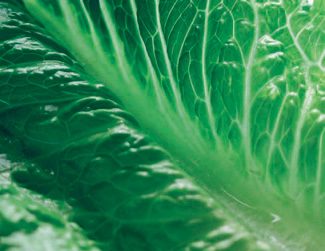
highlights

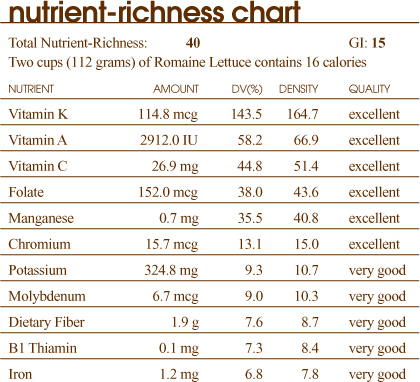
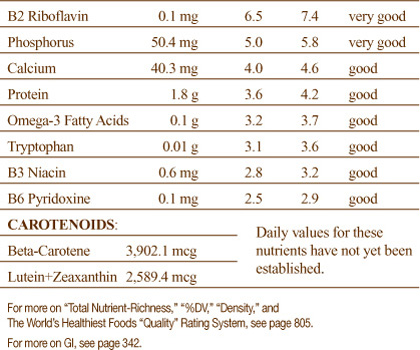
The cultivation of Lettuce may date as far back as 4,500 BC Depictions of Lettuce have been found on ancient Egyptian tombs, and it is believed that Lettuce was held in high esteem by the Greeks and Romans, both as a food and for its medicinal properties. The Chinese consider Lettuce a source of good luck and serve it on birthdays, New Year’s Day and other special occasions. In the West, Lettuce has become an important low-calorie food that is great for weight control. Think crisp leafy Lettuce and refreshing salads come to mind. And by combining a Lettuce salad with chicken, fish, beans, nuts and seeds, you can create a great meal that is limited only by your imagination.
Although Lettuce comes in many shapes, sizes and colors, Romaine Lettuce is one of the most nutritious. Highly regarded for its crunchy texture and low calorie count, its impressive nutritional profile is often overlooked. It is an excellent source of heart-healthy folic acid and chromium, a hard-to-find mineral that is important for maintaining healthy blood sugar levels. Additionally, Romaine Lettuce is a concentrated source of carotenoid phytonutrients, such as betacarotene, lutein and zeaxanthin, which have powerful antioxidant properties. nutrient-rich and low in calories, Romaine Lettuce is great for weight control and an ideal food to add to your “Healthiest Way of Eating”—two cups of fresh Romaine Lettuce contain only 16 calories! (For more on the Health Benefits of Romaine Lettuce and a complete analysis of its content of over 60 nutrients, see page 138.)
Most varieties of Lettuce exude small amounts of a white, milky liquid when their leaves are broken. This “milk” gives Lettuce its slightly bitter flavor and its scientific name, Lactuca sativa, derived from the Latin word for milk. Lettuce is described as head Lettuce or leaf Lettuce. (For more on varieties of Lettuce, see Salads, page 141.)
Most of the domestic harvest of Romaine Lettuce and other salad greens comes from California; they are available throughout the year.
Lettuce is one of the 12 foods on which pesticide residues have been most frequently found. (For more on Pesticide Residues, see page 726.)
Turning Romaine Lettuce into a flavorful dish with the most nutrients is simple if you just follow my 3 easy steps:
1. The Best Way to Select
2. The Best Way to Store
3. The Best Way to Prepare
1. the best way to select romaine lettuce
You can select the best tasting Romaine Lettuce by looking for compact heads with crisp leaves. By selecting the best tasting Romaine Lettuce, you will also enjoy Romaine Lettuce with the highest nutritional value. As with all vegetables, I recommend selecting organically grown varieties whenever possible. (For more on Organic Foods, see page 113.)
Avoid Lettuce with wilted leaves that may have dark or slimy spots. The edge of the leaves should not have brown or yellow discoloration, and the stem ends should not be too brown.
2. the best way to store romaine lettuce
Romaine Lettuce is a delicate vegetable, and if not stored properly, it will become limp and lose not only its freshness, but also up to 30% of some of its vitamins.
Romaine Lettuce continues to respire even after it has been harvested; its respiration rate at room temperature (68°F/20°C) is 101 mg/kg/hr. Slowing down the respiration rate with proper storage is the key to extending its flavor and nutritional benefits. (For a Comparison of Respiration Rates for different vegetables, see page 91.)
1. Store fresh Romaine Lettuce in the refrigerator. The colder temperature will slow the respiration rate, helping to preserve its nutrients and keeping Romaine Lettuce fresh for a longer period of time.
2. Place Romaine Lettuce in a plastic storage bag before refrigerating. I have found that it is best to wrap the bag tightly around the Romaine Lettuce, squeezing out as much of the air from the bag as possible.
3. Do not wash Romaine Lettuce before refrigeration because exposure to water will encourage Romaine Lettuce to spoil.
4. Romaine hearts are usually more durable and will last longer in your refrigerator than the other leaves. If you’re uncertain about consuming your Romaine Lettuce within 7 days, you might want to purchase the romaine hearts.
3. the best way to prepare romaine lettuce
Properly cleaning and cutting Romaine Lettuce helps ensure that the Romaine Lettuce you serve will have the best flavor and retain the greatest number of nutrients.
Rinse well under cold running water to remove any soil before cutting. A salad spinner works best to remove excess water; spin the Lettuce after it has been chopped. If you don’t have a spinner, pat leaves dry to remove excess water before chopping. To preserve nutrients, do not soak Lettuce or its water-soluble nutrients will leach into the water. (For more on Washing Vegetables, page 92.)
I recommend washing prepackaged Lettuce even if the package label says that it has been prewashed.
health benefits of romaine lettuce
Due to its extremely low calorie content and high water volume, Romaine Lettuce is often overlooked in the nutrition world as a very nutritious food. It is delicious, versatile and very filling, making it a very nutritious addition to a “Healthiest Way of Eating” geared towards healthy weight control.
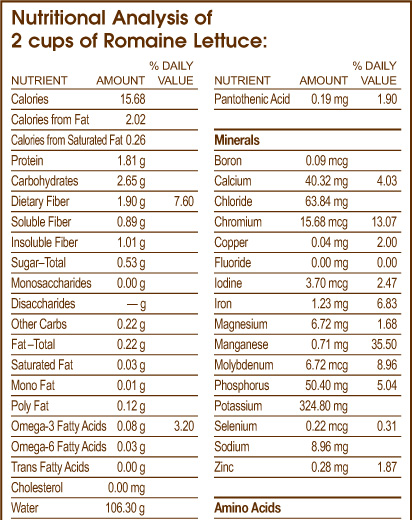
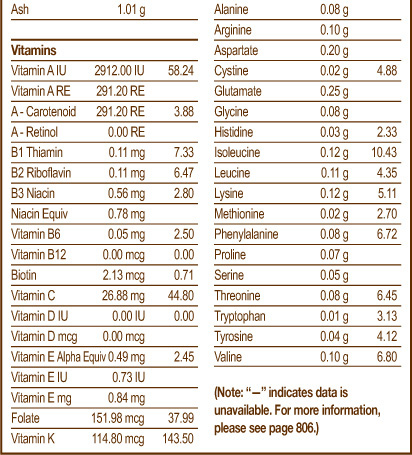
Romaine Lettuce contains nutrients that are good for your eyes. It is an excellent source of vitamin A, which is necessary for the production of rhodopsin, a pigment that allows the eyes to detect small amounts of light. Additionally, Romaine Lettuce is a concentrated source of lutein and zeaxanthin, carotenoid phytonutrients that are thought to protect eyes from light-induced oxidative damage. Studies have found that higher dietary intake of lutein and zeaxanthin is related to a reduced risk of cataracts and age-related macular degeneration.
Romaine Lettuce is an excellent source of chromium, an important mineral for blood sugar regulation. Chromium is a component of glucose tolerance factor (GTF), which helps to sensitize cells to the actions of insulin, the hormone that signals cells to allow glucose to enter. Most people don’t get enough chromium in their diet since food processing methods remove the naturally-occurring chromium in commonly consumed foods.
A recent study found that animals fed a Lettuce-rich diet received a beneficial effect upon cholesterol metabolism and antioxidant status. This may be no surprise when we reflect upon the wealth of heart-healthy nutrients contained in Lettuce. For example, Romaine Lettuce is also an excellent source of folic acid; if folic acid is deficient, it can lead to elevated levels of homocysteine, which damages artery walls, leading to atherosclerosis. Romaine Lettuce is also a good source of vitamin B6, which is also important in maintaining proper homocysteine levels. Romaine Lettuce is a concentrated source of other heart-healthy nutrients including dietary fiber, potassium, calcium, omega-3 fatty acids and niacin.
Romaine Lettuce is also a concentrated source of many other nutrients providing additional health-promoting benefits. These nutrients include energy-producing iron, phosphorus, vitamin B1 and vitamin B2; muscle-building protein; free-radical-scavenging manganese; sulfite-detoxifying molybdenum; and sleep-promoting tryptophan. Since a two cup serving of Romaine Lettuce contains only 16 calories, it is an ideal food for healthy weight control.
STEP-BY-STEP RECIPE
The Healthiest Way to Enjoy Romaine Lettuce
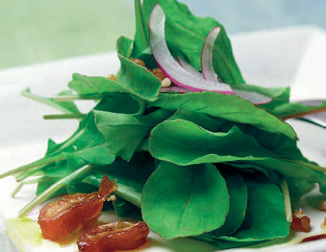
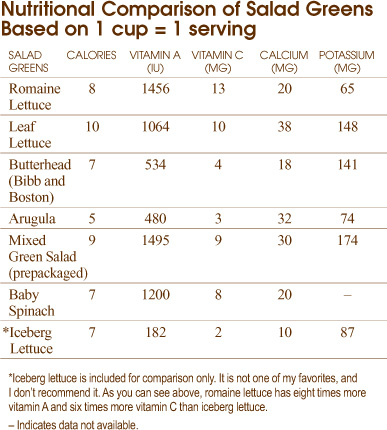
Native to the eastern Mediterranean region and western Asia, the cultivation of lettuce is thought to date back to at least 4,500 BC In fact, depictions of lettuce appeared in ancient Egyptian tombs. Both the ancient Greeks and Romans held lettuce in high regard both as a food and for its therapeutic medicinal properties. The word “Salad” comes from the Latin word salata, meaning “salted.” During the time of the Roman Empire, a common meal consisted of vegetables that had been seasoned with brine, olive oil and vinegar; it was called herba salata, or “salted vegetables.” I like this original meaning of the word “Salad” because I think that vegetables are such an important part of what Salads are all about!
A Salad containing a wide variety of vegetables—including root vegetables, green leafy vegetables, stalks, stems and flowers—makes a great foundation upon which to build a complete meal.
The use of seeds, nuts, and beans in Salads is extremely helpful in contributing protein, fiber, minerals and omega-3 fatty acids to the meal. Small amounts of “garnish” ingredients—like a tablespoon of pumpkin seeds or a sprinkling of walnuts—are a very worthwhile addition in terms of nutrients. Trace minerals and small amounts of high-quality omega-3 fats are nutrients of which most U.S. adults don’t get nearly enough, and it doesn’t take many pumpkin seeds or walnuts to bring at least some of these vital nutrients into the day’s meal plan.
A variety of lettuce and greens provide health-promoting phytonutrients. For example, different Salad greens offer distinct flavonoid phytonutrients. Green leaf varieties have the flavonoid quercetin, but you’ll need red leaves to get any of the cyanidin flavonoids. To get good supplies of kaempferol, you may want to include some endive. The different colors in the leaves may not seem significant, but each shading represents a different combination of flavonoids and other pigments; researchers are continually learning about different ways in which these flavonoids and pigments help prevent disease.
The best Salad includes a variety of different types of lettuce. Not only will including a variety of lettuces in your meal plan allow you to enjoy a host of different flavors and textures, but you can also enjoy the range of nutrients that each lettuce variety has to offer. And offer nutritional value they do! In fact, many lettuces really pack a punch when it comes to their vitamin and mineral content. As you see from the chart on the previous page, the different varieties are nutritionally distinct.
Fortunately, there’s an amazing variety to choose from. Lettuce can usually be divided into four basic varieties:
Also known as Cos, this variety of head-forming lettuce has deep green, long leaves with a crisp texture and robust flavor. Paris Island is the most popular variety featuring a semi-dark green, stiff, upright leaf. Green Towers, with slightly larger leaves, and Cimmaron, an unusual dark red Cos type, are also available in some areas.
This type of lettuce features tender large leaves, which form a loosely arranged head that is easily separated from the stem. It has a sweet flavor and a soft texture. The best known varieties of Butterhead lettuce include Boston and Bibb.
A favorite of many home gardeners. Featuring broad, curly leaves that are green and/or red, the leaf lettuces offer a delicate taste and a mildly crisp texture. This variety is much more delicate than the crisp-head variety and also much more diverse and flavorful. Best known varieties of leaf lettuce include green leaf and red leaf. Green leaf lettuces include Black-seeded Simpsons, Grand Rapids and Oak Leaf lettuce. Red leaf varieties include Red Fire, Red Sails and Ruby.
These prewashed and ready-to-use greens save a lot of time. Organic mixed greens come in three varieties: Salad mix, spring mix and herb mix. They have a longer shelf life because packages are sealed so that the greens have no contact with the air.
Special names for mixed greens are, in fact, part of the everyday language in France and Italy. For the French, mixed greens are often described under the heading of “mesclumo.” Mesclumo is part of the Niçois dialect and means “mixture.” In the United States, mesclumo is usually referred to as “mesclun mix.”
The idea of a greens mix in France is not simply to get any old mixture of greens. The idea is to combine four basic flavor types through a careful mixing of greens: mild, bitter/tart, piquant and pepper/spicy. For the mild component, a leaf lettuce will typically be included. For the piquant, perhaps mustard greens. For the bitter/tart flavor, either radicchio, escarole, mizuna or curly endive. To round out the peppery/spicy component, usually included is either arugula or watercress.
Sprouts can make great toppings for Salads. They are also a great addition to sandwiches.
In the life of a plant, sprouting is a moment of great vitality and energy. The seed, after having remained quiet, often for a long period of time, becomes more and more active and begins its journey up through the topsoil and into the open air. When it sprouts, a healthy seed activates many different metabolic systems. It converts some of its sugar content into vitamin C to act as an antioxidant in the new open air environment. It also begins to synthesize a variety of new enzymes, many of them necessary to handle oxygen metabolism in the world above the soil. On a gram for gram basis, sprouts are richer in vitamin C than the older, more mature plants they eventually become because this moment in their lifecyle calls for a high level of vitality. Sprouts can definitely be good for you!
For you to get the benefit of healthy sprouts, the sprouts need to be very fresh and carefully refrigerated and handled. Most any kind of seed could also be sprouted at home, using one part seed to three parts water, a wide-mouth glass jar and a screened lid. Many health food stores and natural foods groceries have sprouting starter kits that make the process easy to understand and complete. It’s worth noting here that seeds are smart, and some will not do much sprouting in polluted tap water, making a cleaner water source (like bottled spring water or filtered water) a better choice when sprouting. Although mung bean sprouts and alfalfa sprouts are the most common commercially available sprouts, equally easy-to-sprout and healthy are red clover, radish, mustard, lentil, adzuki, garbanzo, pumpkin seeds and sunflower seeds. One word of caution about alfalfa: this seed has higher than usual amounts of an amino acid called canavanine, and some research studies have associated canavanine with worsening of inflammatory conditions including rheumatoid arthritis and systemic lupus erythematosus. Individuals with chronic inflammatory conditions, including autoimmune conditions, may want to avoid alfalfa sprouts for this reason.
If you decide to include raw sprouts in your “Healthiest Way of Eating” for their health benefits, here are some steps you can take to help make sure that they are safe to eat:
• Wash all sprouts thoroughly with filtered water before eating them.
• Look for the International Sprout Growers Association (ISGA) seal on the package. If you are buying bulk, ask your grocery if the sprouts are ISGA-approved.
• If the sprouts are prepackaged, only purchase if the sell-by date is current or even a few days ahead.
• If you’re buying in bulk, ask your grocery about the sell-by date.
• Examine the sprouts to make sure the roots are clean. If the stem color is not white or creamy, do not purchase them. Do not purchase sprouts if the buds are no longer attached, if they are dark in color or have a musty smell.
• Keep the sprouts refrigerated.
• After 2 days, compost them rather than consuming them yourself.
• If you are sprouting seeds at home, follow the same guidelines described above. Learn about the source of your seeds, their ISGA certification, and either have your grocery confirm high-quality standards for seed production or obtain contact information for the seed source and contact that company yourself.
• Follow the above guidelines regardless of the type of seeds you are sprouting, i.e., apply the guidelines to mung, alfalfa, radish, broccoli, lentil, sunflower and all other types of sprouts.
It is easy to make a tasty Salad. Salad greens are often premixed and prewashed (although I always like to wash them again). Since conventionally grown lettuce has been found to have a high concentration of pesticide residues, always try to buy organically grown varieties.
To make a good tasting Salad, I always start with crisp, vibrantly colored lettuce with no signs of yellowing or wilting. Cleaning lettuce and greens is pretty simple. If you are using a head variety lettuce, first remove the outer leaves. For all lettuces, you can slice off the tips of the leaves, since they tend to be bitter, and discard the bottom root portion. Chop the remaining lettuce, rinse and pat dry or use a Salad spinner, if you have one available, to remove the excess water.
Wash loose Salad greens like you would spinach. Trim their roots and separate the leaves, placing them in a large bowl of tepid water and swishing them around with your hands. This will allow any sand to become dislodged. Remove the leaves from the water, empty the bowl, refill with clean water and repeat this process until no dirt remains in the water (usually two or three times will do the trick).
Drying Salad greens well helps to prevent diluting your dressing. Dry Salad greens require less dressing and therefore will create a Salad that contains fewer calories and more flavor. To dry Salad greens, I love to use a Salad spinner.
One obstacle to eating fresh, raw vegetables is the time it takes to clean and chop them. Using a Salad spinner can help you throw together a fresh, nutritious Salad, even when you are in a hurry. Salad spinners are available at kitchen shops (a $25–$30 investment); make sure to get one with a tight fitting lid. All Salad spinners have the same basic design elements including an inner basket that fits into a larger bowl with gears that are connected to a mechanism on the lid. Turning or pumping a handle on the top of the lid causes the inner basket to spin rapidly; the resulting centrifugal force pulls the greens to the side of the basket and the water on the leaves into the outer bowl. The different types of spinners seem to work equally well for drying greens; using a Salad spinner definitely beats patting greens with a towel!
Chop or shred the lettuce into bite-size pieces and place the lettuce into the inner bowl of your spinner. Carefully wash the lettuce with cold water, and then return the inner bowl to fit inside the outer bowl and spin the lettuce dry in the Salad spinner. The spinning process only takes about one minute. Next, empty the liquid in the bottom of the Salad spinner—you can either keep it and use it for soup stock or just discard it into your vegetable garden. Then replace the lid on the spinner and put the whole container in the refrigerator until you are ready for Salad. When stored in your Salad spinner, this clean, chopped lettuce will keep in the refrigerator for two days.
With a bowl full of already washed and chopped lettuce, you’ll enjoy eating Salad with more and more meals. (One side note: if you decide to try spinning vegetables in your Salad spinner along with the lettuce, make sure you stick with the more solid, less watery type of vegetable. For example, green pepper slices and carrot slices can spin right along with the lettuce, but cucumbers and tomatoes can’t—their watery nature cannot withstand the pressure of the spinner, and they will break apart in the process.)
STEP-BY-STEP RECIPE
The Healthiest Way to Make Salad
There are hundreds of ways to make your Salad more nutritious. You can mix in grated carrots, beets and jicama or just add sprouts on top. Thin slices of cucumber, small pieces of sweet red or green bell pepper, summer squash, radish, scallions, cherry tomatoes, a sprinkling of nuts or seeds, even a few freshly washed berries…any and all make tasty colorful additions. Make sure your Salad has a rainbow of colors to maximize not only eye appeal, but flavor and nutritional value. Here are several ideas for healthy salads and dressings.
In a small bowl, combine 1 clove pressed garlic, 2 TBS fresh lemon juice, 2 TBS extra virgin olive oil, 2 minced anchovies, 1 TBS Parmesan cheese, and salt and pepper to taste. Toss 4 cups of romaine lettuce with dressing. Top with 1/4 cup walnuts.
Combine in a mixing bowl: 1 cup cooked diced chicken breast, 1 diced apple, 1 diced celery stalk, 1/4 cup chopped walnuts, 2 TBS chopped parsley, 3 TBS extra virgin olive oil, 2 TBS fresh lemon juice and sea salt and pepper to taste.
Combine 4 cups Salad greens, 2 TBS chopped mint, 3 TBS crumbled feta cheese, 2 TBS chopped olives, and salt and pepper to taste. Toss with 3 TBS extra virgin olive oil and 1 TBS red wine vinegar. For a variation of this salad, see page 289.
This Salad is made with ingredients you have on hand. Be creative. Here are the basic ingredients: 2 cups of Salad greens, canned tuna, sliced tomatoes, chopped anchovies, chopped olives, chopped onions and capers. Top with your favorite vinaigrette. For more details, see page 181.
Slice 2 large, ripe tomatoes and arrange on a platter. Add one slice of fresh buffalo mozzarella cheese and one basil leaf to each tomato slice. Whisk together 1/4 cup extra virgin olive oil, 2 TBS balsamic vinegar, 2 cloves pressed garlic, and sea salt and pepper to taste. Drizzle dressing over tomato, cheese and basil mixture.
Top 4 cups of chopped mixed greens (spinach, romaine, arugula) with 4 oz chicken or turkey slices, 4 oz grated low-fat cheese (cheddar, goat cheese or blue cheese), and 1/4 cup each of cucumbers, tomatoes, bell peppers and celery. Sprinkle with 3 TBS walnuts and your favorite Healthy Vinaigrette (see page 143).

Put everything, except blue cheese, in blender and blend until smooth. Add blue cheese and pulse 2–3 times.

In a blender, blend all ingredients except olive oil and salt and pepper until smooth. With blender running, slowly pour in olive oil until emulsified. Season to taste with sea salt and pepper.
The World’s Healthiest Foods are concentrated in important nutrients that the body needs to promote optimal health. As an example, the chart below shows the nutrient richness of spinach and describes the essential functions of each nutrient and how it contributes to energy, health and vitality. 1 cup of boiled spinach: (180 grams): 41 calories

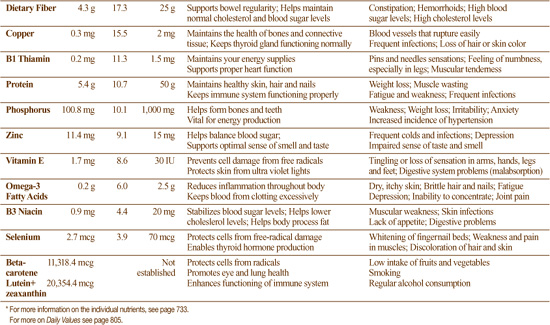


highlights

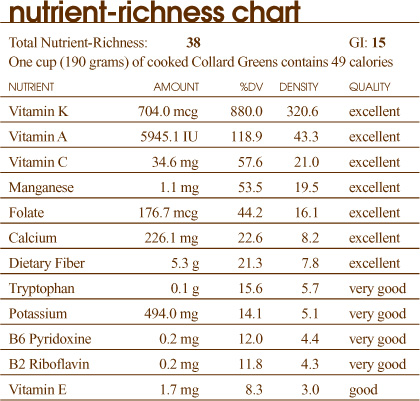
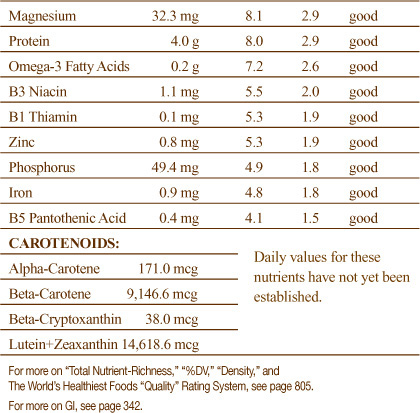
Collard Greens are native to the Mediterranean and were popular with both the ancient Greeks and Romans. Their smoky flavor and meaty texture have long made them a staple in the Southern United States, and they are now becoming increasingly popular throughout the rest of the country. If you are not familiar with Collard Greens, I highly recommend you try them. Proper preparation of Collard Greens is the key to bringing out their best flavor and maximizing their nutritional benefits. That is why I want to share with you the secret of the “Healthiest Way of Cooking” Collard Greens al denté. In just 5 minutes, you will be able to serve Collard Greens with the most flavor and the maximum nutritional value.
Although cultivated since ancient times, Collard Greens’ many nutritional benefits have only been recently identified. Scientific studies now show that cruciferous vegetables, like Collard Greens, are included among the vegetables that contain the largest concentrations of health-promoting sulfur compounds such as glucosinolates and the methyl cysteine sulfoxides (see page 153), which increase the liver’s ability to produce enzymes that neutralize potentially toxic substances. Collard Greens are also an exceptional source of the powerful phytonutrient antioxidants lutein and zeaxanthin. And if you want to increase your calcium intake, Collard Greens are one of the best plant-based sources of this important mineral. Collard Greens are an ideal food to add to your “Healthiest Way of Eating” not only because they are high in nutrients, but also because they are low in calories: one cup of cooked Collard Greens contains only 49 calories. (For more on the Health Benefits of Collard Greens and a complete analysis of their content of over 60 nutrients, see page 150.)
Collard Greens (Brassica Oleracea var. viridis) are one of the non-head forming members of the cruciferous family of vegetables, which also includes broccoli, cauliflower, kale, cabbage, mustard greens and Brussels sprouts. While Collard Greens and kale share the same botanical name, they each have their own distinctive qualities. The most popular and widely available variety of Collard Greens features dark, relatively broad, blue-green leaves, which are smooth in texture and lack the frilled edges characteristic of their cousin, kale. This is the variety featured in the photographs in this chapter.
Collard Greens are available throughout the year, but their flavor is at its peak during the cold months when the frost helps to develop a sweet flavor. In hotter months, Collard Greens are less tender and will require around 1 minute additional cooking time.
Collard Greens are a concentrated source of goitrogens and oxalates, which might be of concern to certain individuals. (For more on: Goitrogens, see page 721; and Oxalates, see page 725.)
Turning Collard Greens into a flavorful dish with the most nutrients is simple if you just follow my 4 easy steps:
1. The Best Way to Select
2. The Best Way to Store
3. The Best Way to Prepare
4. The Healthiest Way of Cooking
1. the best way to select collard greens
You can select the best tasting Collard Greens by looking for varieties that have firm, fresh leaves with a vivid, bright, deep green color. I have found that Collard Greens with smaller leaves are usually the best because they are more tender and have a milder flavor. By selecting the best tasting Collard Greens, you will also enjoy those with the highest nutritional value. As with all vegetables, I recommend selecting organically grown varieties whenever possible. (For more on Organic Foods, see page 113.)
Avoid Collard Greens that show signs of yellowing or browning.
2. the best way to store collard greens
Collard Greens are delicate and will wilt and turn yellow if not stored properly. If care is not taken with their storage, they can also lose much of their flavor and up to 30% of some of their vitamins.
Collard Greens continue to respire even after they have been harvested. Slowing down the respiration rate with proper storage is the key to extending their flavor and nutritional benefits. (For a Comparison of Respiration Rates for different vegetables, see page 91.)
1. Store Collard Greens in the refrigerator. The colder temperature will slow the respiration rate, helping to preserve their nutrients and keeping Collard Greens fresh for a longer period of time.
2. Place Collard Greens in a plastic storage bag before refrigerating. I have found that it is best to wrap the bag tightly around the Collard Greens, squeezing out as much of the air from the bag as possible.
3. Do not wash Collard Greens before refrigeration because exposure to water will encourage Collard Greens to spoil.